Look at a map of Chile and its shape instantly stands out. It’s a long and narrow coastal country measuring about 4,329 kilometers (2,690 miles) from north to south.
With all that coastline, it only follows that seafood plays an important role in the Chilean diet. Since pre-colonial times, its been home to a diverse array of fish and seafood, not to mention a wide range of agricultural products like potatoes, beans, fruits, and vegetables.
With the arrival of the Spanish conquistadores came wheat, livestock, and wine, all of which have become vital components of Chilean cuisine. Today, Chile is consistently one of the biggest producers of wine in the world.
With so much going for it, Traveleaters doing a South American food tour will have plenty to look forward to in Chile.
CHILEAN FOOD QUICK LINKS
If you’re planning a trip to Chile and want to really dive into the cuisine, then you may be interested in going on a food tour.
TOURS & OTHER SERVICES
- Chilean Food Tours: Food and Wine/Drinking Tours in Chile
- eSIM: Chile eSIM
Save This on Pinterest!
No time to read this article on Chilean food? Click on the save button and pin it for later!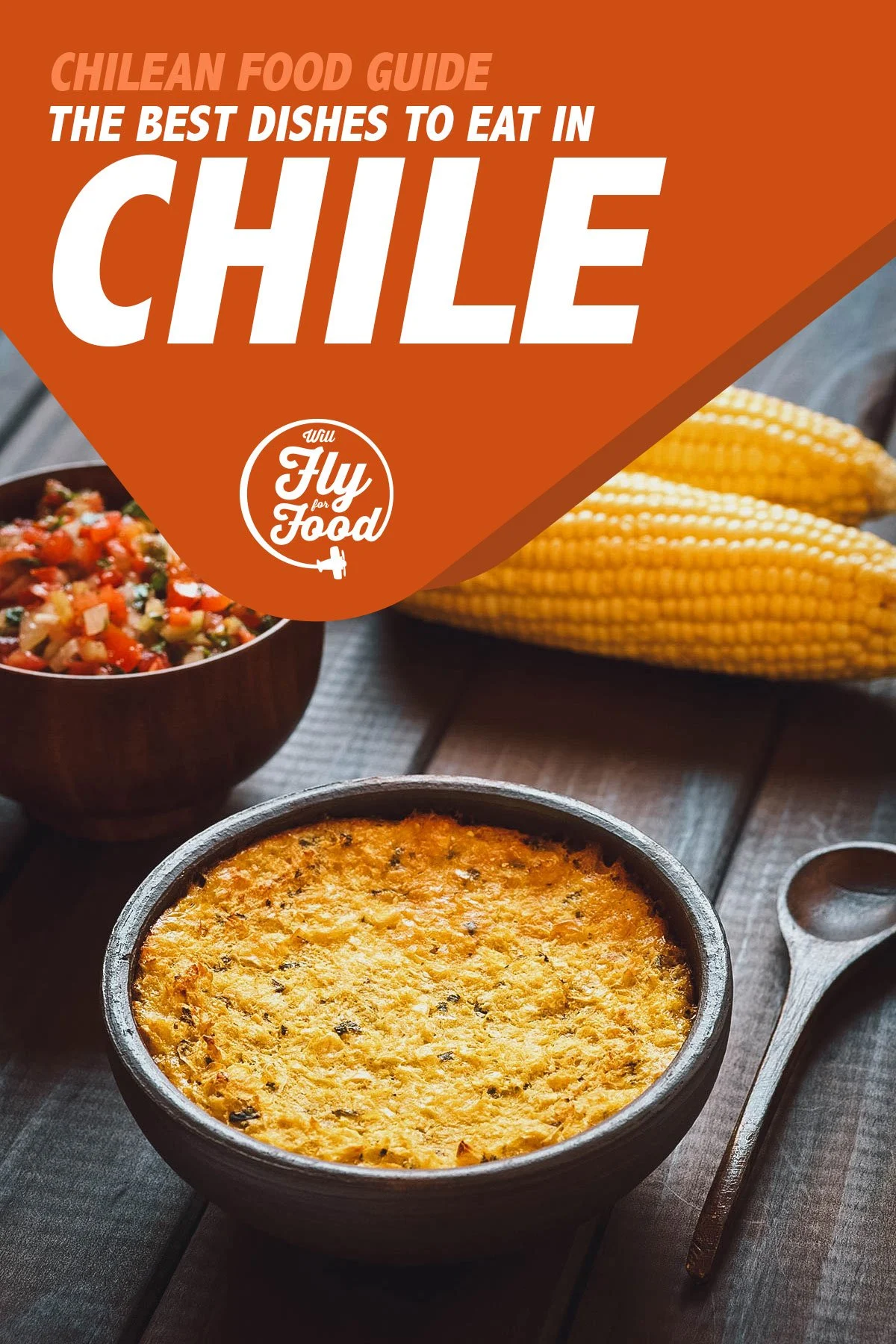
Photo by ildi_papp
WHAT IS TRADITIONAL CHILEAN FOOD?
Chilean food can best be described as a fusion of Spanish influences with local Mapuche culture and ingredients. Thanks to its diverse geography and oxygen-rich waters, it’s home to a wide range of agricultural products and a unique variety of fish and seafood.
Since colonial times, Chilean lunches have been the biggest and most important meal of the day. It typically starts with a fish, meat, or poultry dish followed by a stew with choclo and potatoes. Three types of bread often accompany meals which usually end with dessert and herbal tea to aid in digestion.
Between the late 19th and early 20th centuries, the Chilean government actively encouraged immigration. This led to the arrival of immigrants from countries like Germany, Italy, France, the UK, Croatia, Belgium, and Greece. They left an indelible imprint on the local cuisine and helped steer the course of Chilean gastronomy.
THE BEST OF CHILEAN CUISINE
This article on Chilean food has been organized by category to make it easier to digest. Click on a link to jump to any section of the guide.
STARTERS / SIDES / SNACKS
1. Huevos Revueltos
What better way to start your day in Chile than with a breakfast of huevos revueltos or Chilean scrambled eggs? It’s a popular breakfast dish in the Chilean countryside where it’s often served with fresh tomatoes and pan amasado (Chilean kneaded bread).
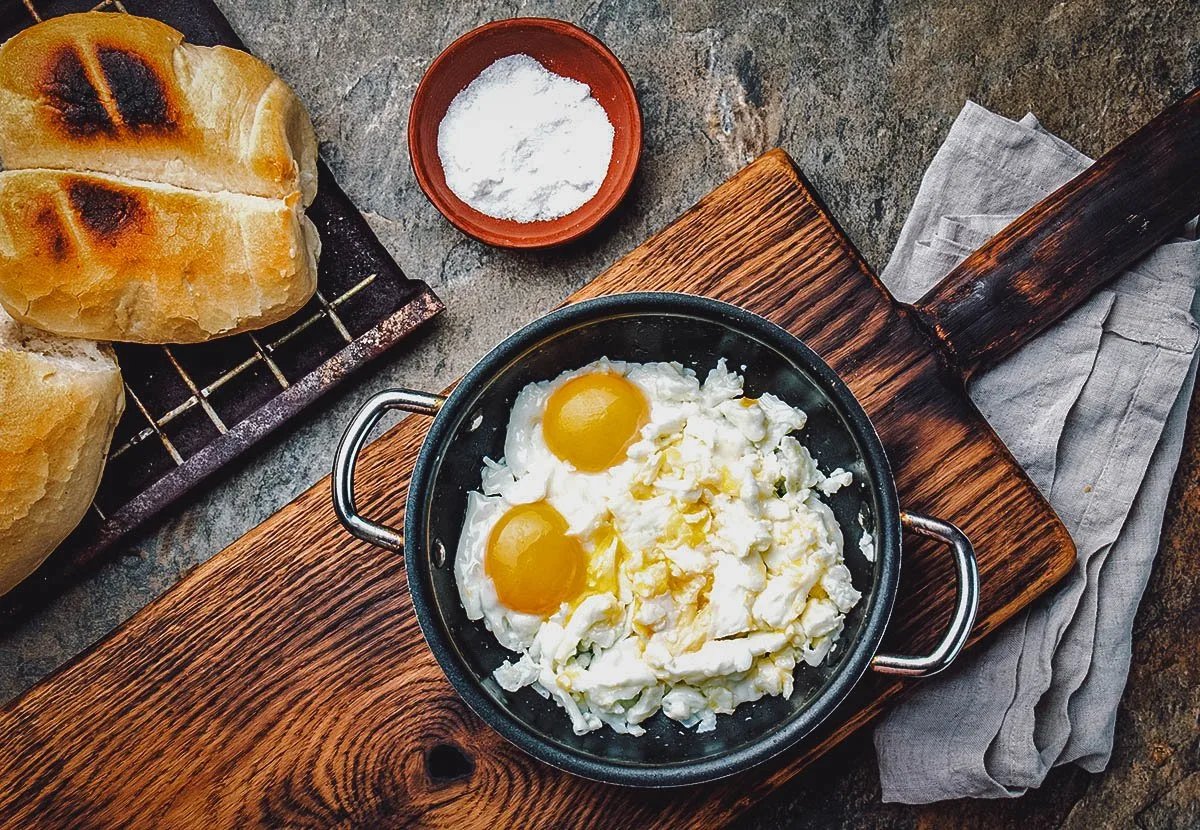
Photo by Blinovita
2. Humitas
Humitas refers to an ancient pre-Hispanic Andean dish consumed in Chile, Bolivia, Ecuador, Peru, and northwest Argentina. Similar to tamales, it consists of mashed corn mixed with basil, onion, aji verde (green chili pepper), butter or lard, and spices. The mixture is wrapped in fresh corn husks and either steamed or boiled.
Chilean humitas are typically plain in taste but they can be seasoned to be more savory, sweet, or sweet and sour. They’re often enjoyed as is or paired with a side or ensalada chilena or pebre salsa.
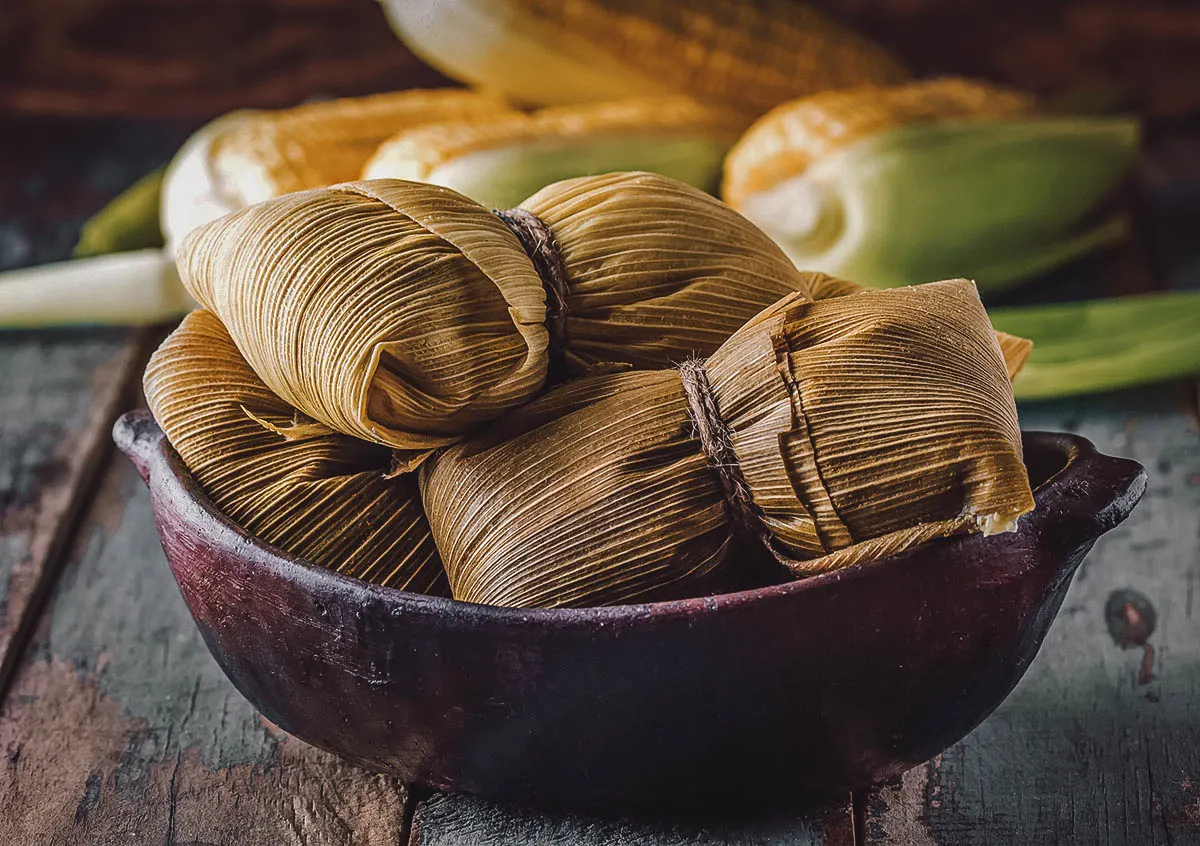
Photo by Blinovita
3. Papa Rellena
Papa rellena refers to a type of croquette popular in the cuisines of many Latin American countries like Chile, Bolivia, Peru, Ecuador, Colombia, and the Dominican Republic. It consists of an oblong-shaped mass of potato dough filled with spiced ground beef, onions, olives, and hard-boiled eggs.
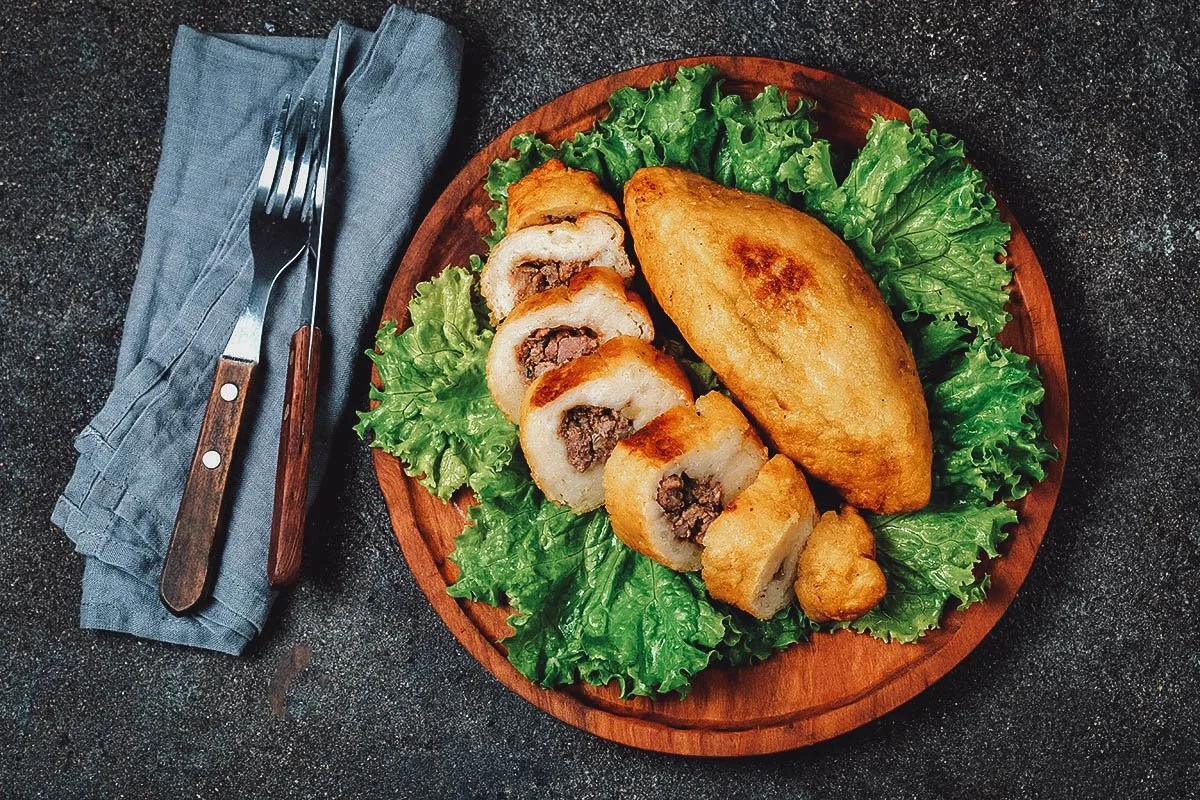
Photo by Blinovita
4. Niños Envueltos
Niños envueltos literally means “wrapped children” and can refer to both Chilean steak rolls (pictured below) or stuffed cabbage rolls. The former is made with pieces of steak wrapped around a filling of vegetables, while the latter consists of ground meat and rice wrapped inside cabbage leaves.
Chilean steak rolls are especially popular among children. Recipes vary from household to household but they’re typically made with flank steaks stuffed with chard leaves, zucchini, and carrots. The steaks are rolled and held together with toothpicks before being browned in a pan and stewed with tomato sauce, mushrooms, and vegetables.
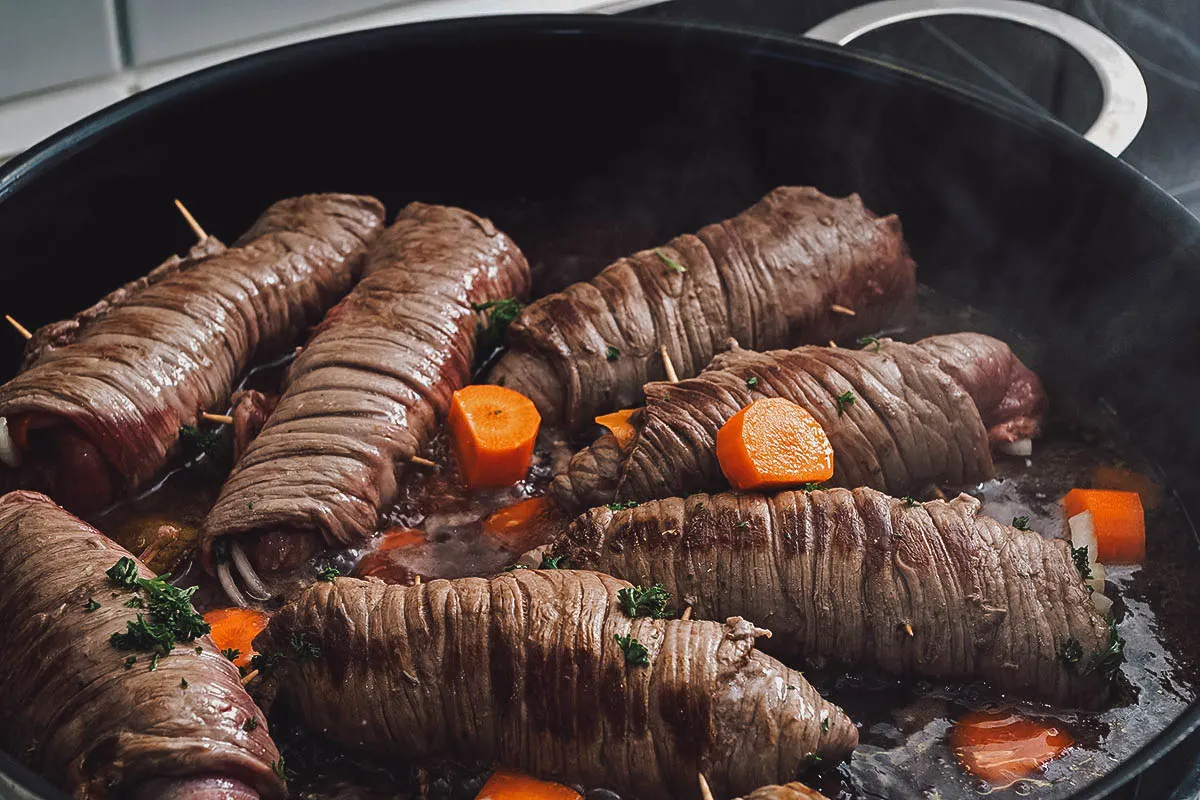
Photo by LieselF
People familiar with Balkan food may recognize this variation of niños envueltos as the Chilean version of sarma. It’s a form of wrapped dolma that’s popular in the cuisines of many countries throughout the Balkans, Central Europe, the South Caucasus, and the Middle East.
Like sarma, niños envueltos are made with blanched cabbage leaves wrapped around a filling of ground beef, rice, garlic, onions, herbs, and spices. The rolls are formed into cylinders and cooked in tomato sauce.
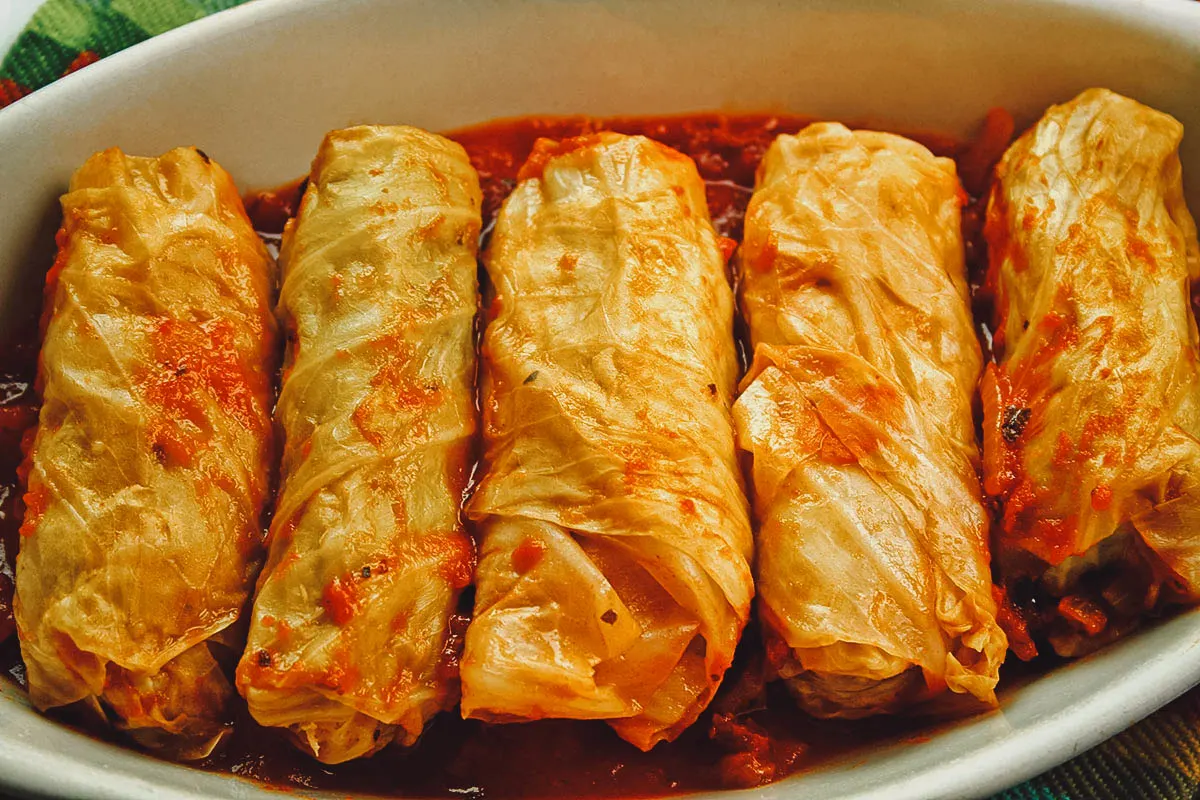
Photo by jabiru
5. Chochoca
Chochoca (or chochoyeco, trotroyeco, trutru) refers to a Chilean festival dish originally from Chiloé. It consists of a dough made with potatoes and flour wrapped around a metal cylinder that resembles a large rolling pin. Like roast pig, the cylinder is rotated slowly for about thirty minutes to roast the dough over hot charcoal.
When cooked, the chochoca is sliced into pieces and eaten on its own or filled with chicharrones. As you can imagine, it isn’t the type of dish that’s typically made at home, but reserved for festive occasions like fiestas and food fairs.
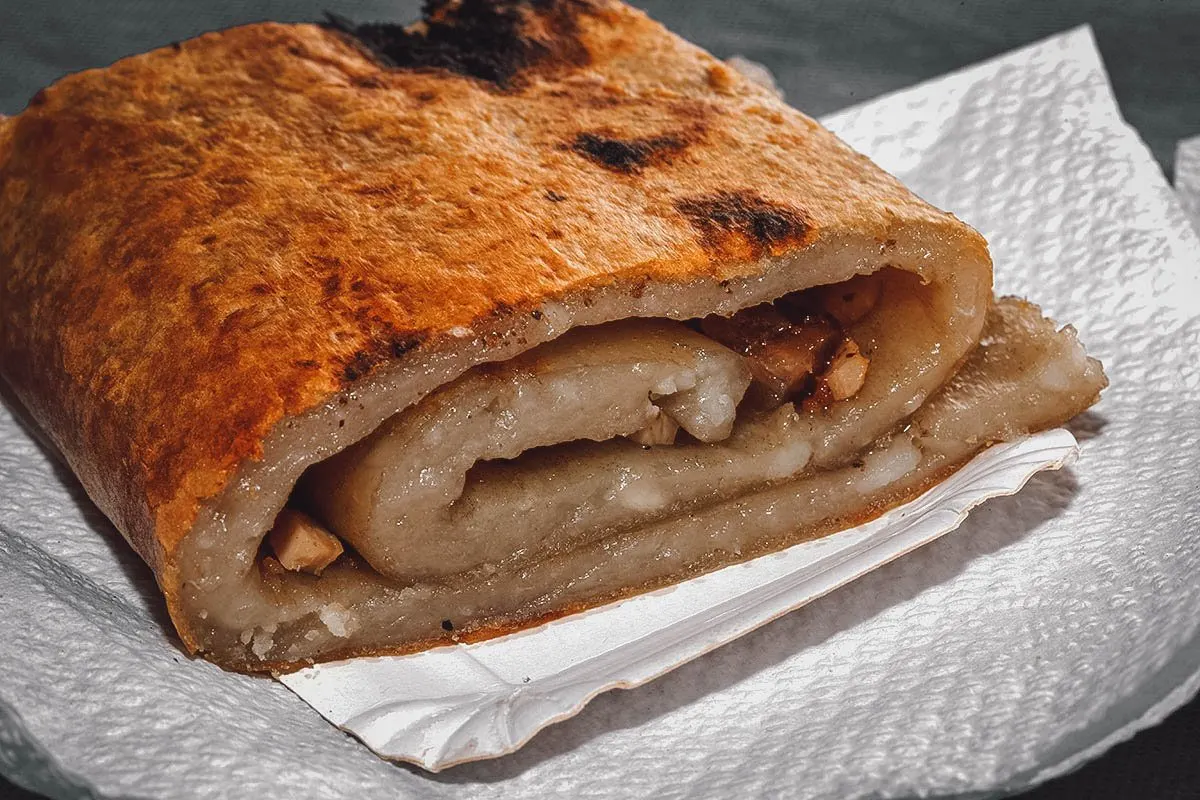
Photo by Blinovita
Here’s a look at the chochoca as it roasts. There are two variations of chochoca depending on the type of dough used – a black version and a white chochoca.
Black chochoca is the more traditional of the two and made with grated raw potatoes mixed with ground cooked potatoes, salt, and lard. The white version is more common and made with equal parts wheat flour and ground cooked potatoes.
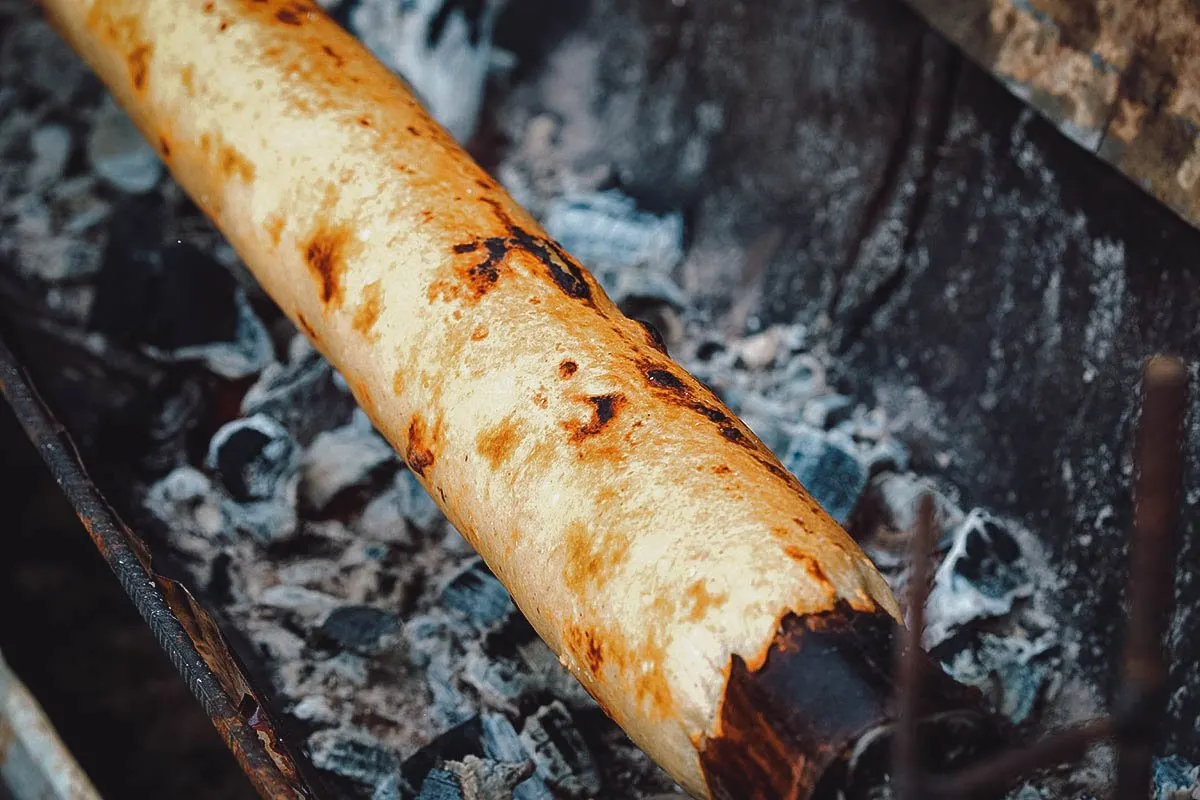
Photo by Blinovita
6. Pebre Salsa
Pebre salsa is an often used Chilean condiment made with aji peppers, coriander, onions, tomatoes, garlic, vinegar, and olive oil. Similar to Mexican pico de gallo, it’s typically served in a clay dish and enjoyed with warm bread like marraqeuta (Chilean bread) or used as a condiment with meat dishes like choripan.
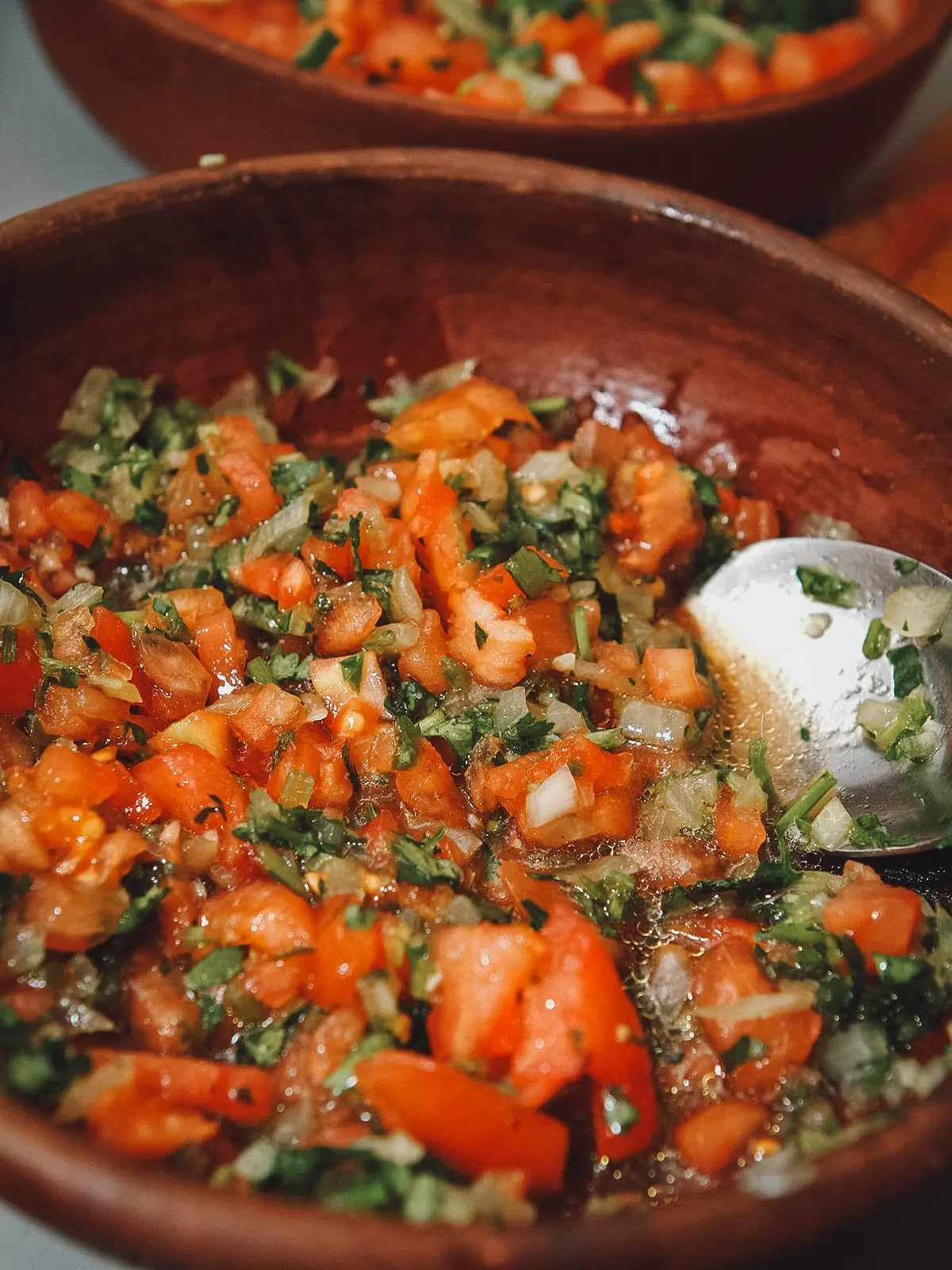
Piterquin, CC BY-SA 4.0, via Wikimedia Commons
7. Cochayuyo
Cochayuyo (or rimurapa) refers to a large species of southern bull kelp (Durvillaea antarctica) found in the waters of Chile, southern New Zealand, and Macquarie Island. As you can see below, cochayuyo is known for its internal honeycomb structure that helps keep it afloat and prevents the kelp from being damaged by strong waves.
Archaeological evidence suggests that cochayuyo has been a staple Chilean food for thousands of years. It’s a protein-rich plant that’s often added to Chilean stews, salads, and ceviches. It’s relatively mild in flavor but its unique honeycomb structure imparts a chewy texture and natural brininess to Chilean dishes.
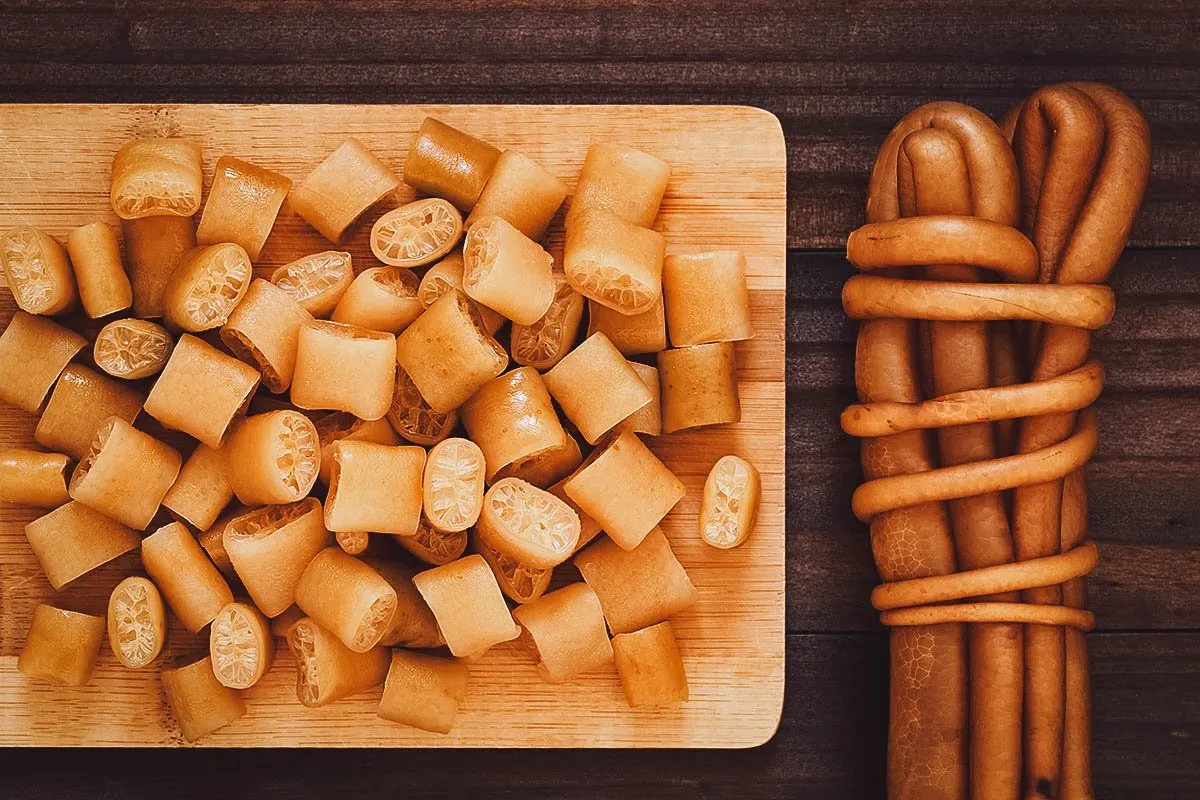
Photo by ildi_papp
Pictured below is a type of fresh Chilean salad made with cochayuyo, tomatoes, cucumber, herbs, and olive oil.
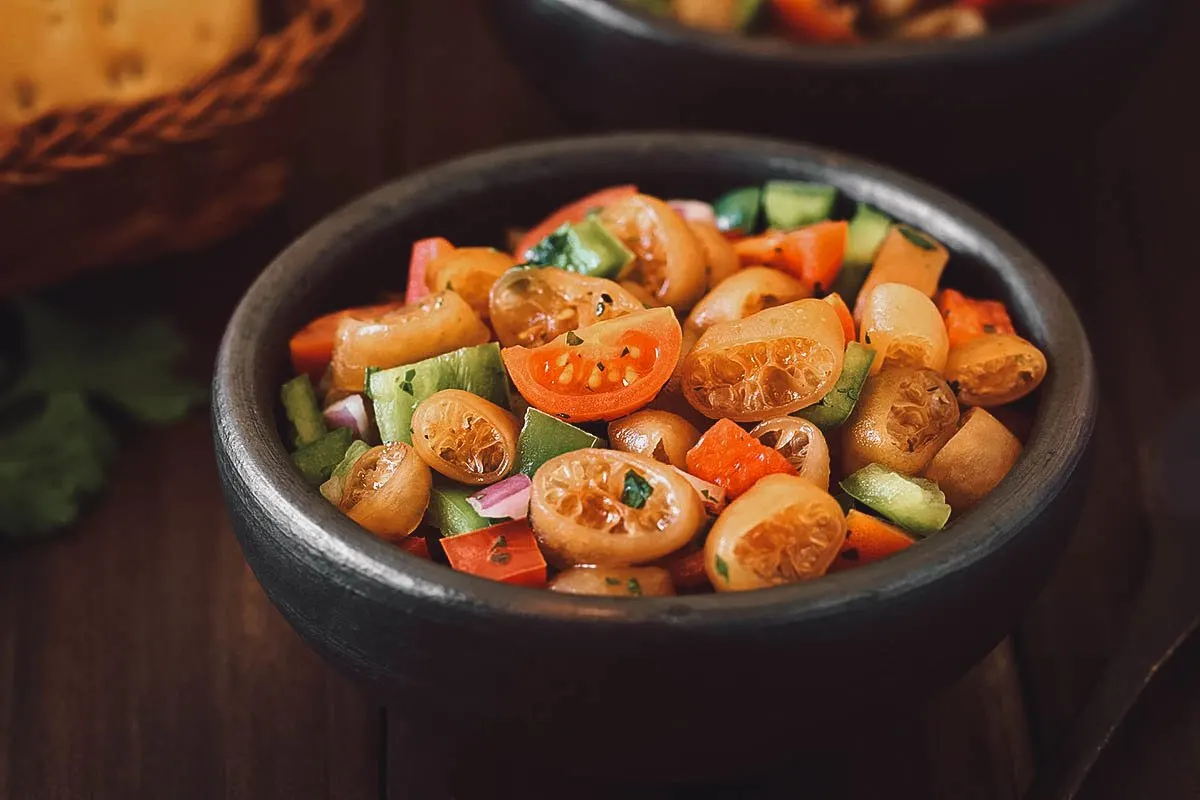
Photo by PantherMediaSeller
Here’s a version of pebre salsa made with the addition of cochayuyo.
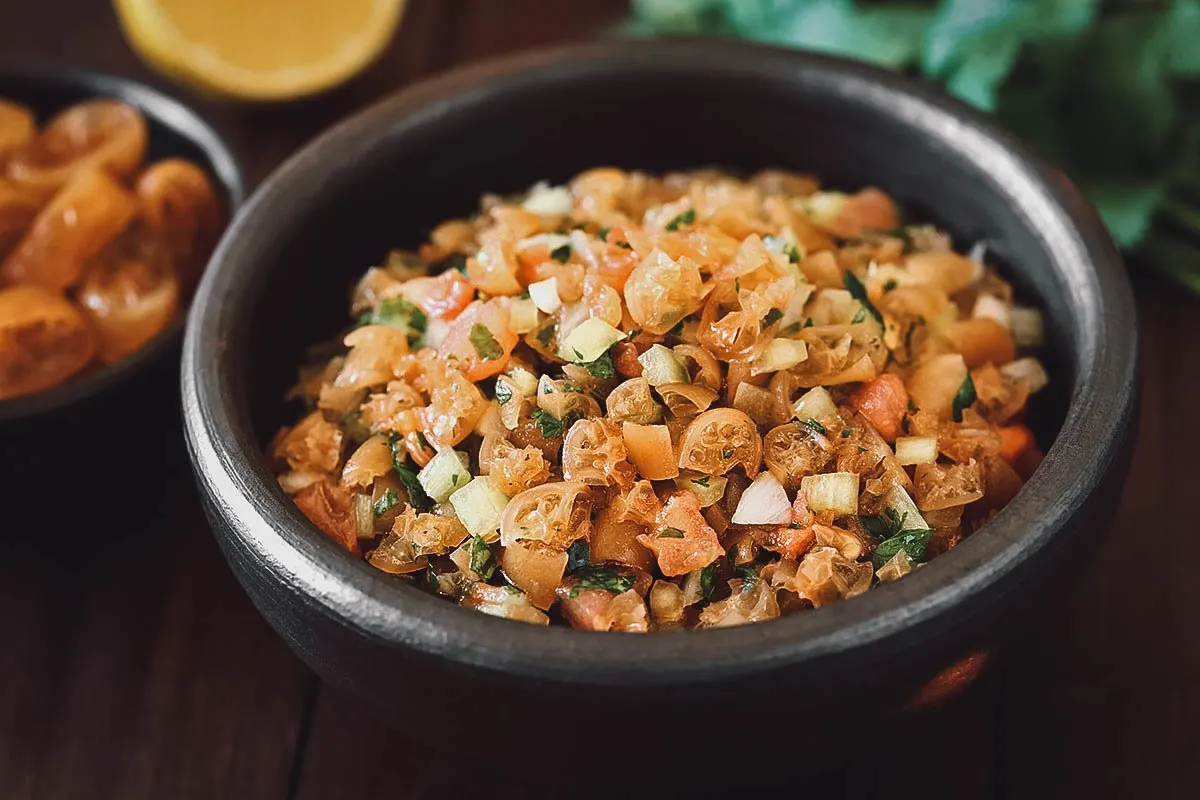
Photo by ildi_papp
8. Quinoa
Quinoa has been a dietary staple for people living in the Andean region for thousands of years. For much of its history, it’s been stigmatized as low status “Indian food” though it’s developed a reputation in recent decades as a type of superfood.
Quinoa is often mistaken for a grain like wheat and barley but it’s actually an herb derived from a flowering plant. Aside from its many nutritional benefits, it’s championed for its pleasant flavor and versatile cooking qualities.
In Chile, quinoa is used in a multitude of dishes like salads, soups, rellenos (stuffed dishes), pudding, and ceviche.
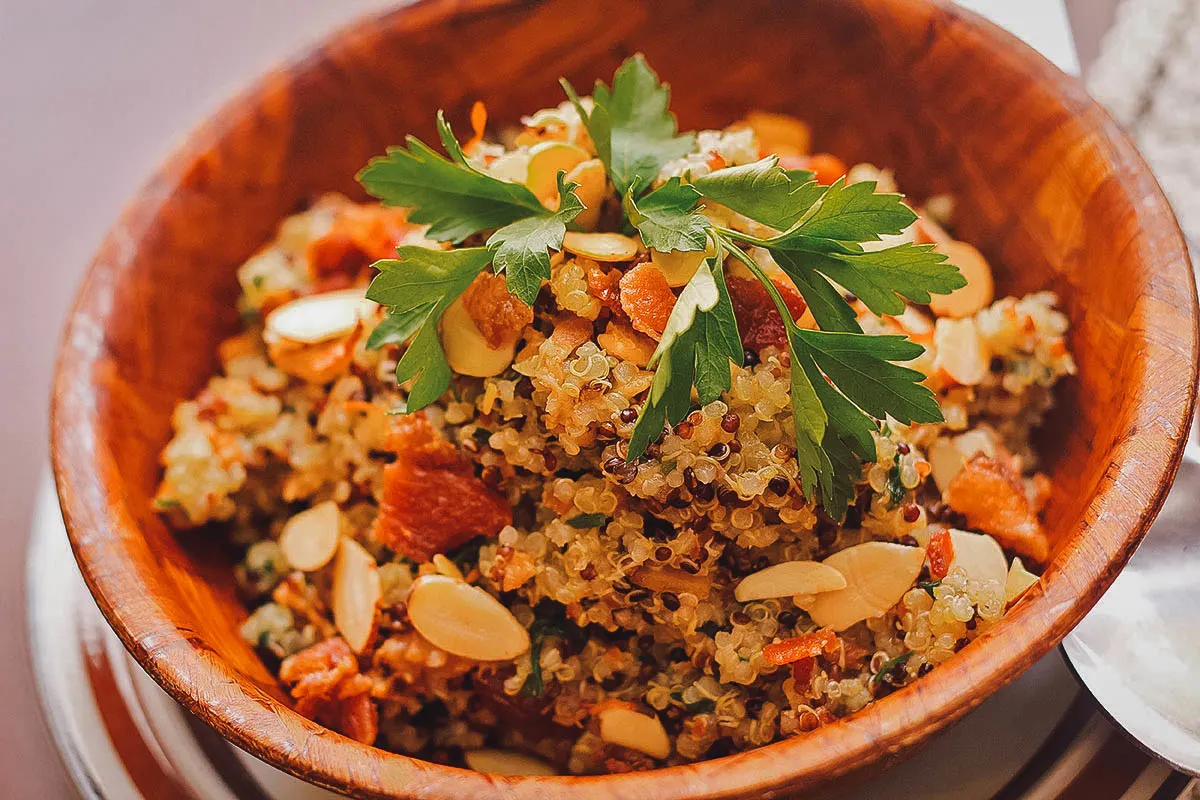
Photo by ezumeimages
SOUPS / STEWS
9. Valdiviano
After a night of drinking in Santiago, you’ll probably want to tuck your head into a bowl of valdiviano, a traditional Chilean soup from southern Chile. Originally from the city of Valdivia, it’s become popular throughout the country where it’s often touted as a hangover cure.
Chilean recipes for valdiviano vary but it’s typically made with thin strips of charqui (Chilean beef jerky) or leftover beef cooked in a soup with onions and various herbs and spices like oregano, parsley, cumin, and paprika. Depending on the cook, other ingredients like potatoes and eggs may be added as well. When made with potatoes, the dish becomes known as ajiaco.
Valdiviano is said to have been invented at the turn of the 17th century. Spanish soldiers stationed in Valdivia were supplied with large amounts of charqui from central Chile which they used to create this soup.
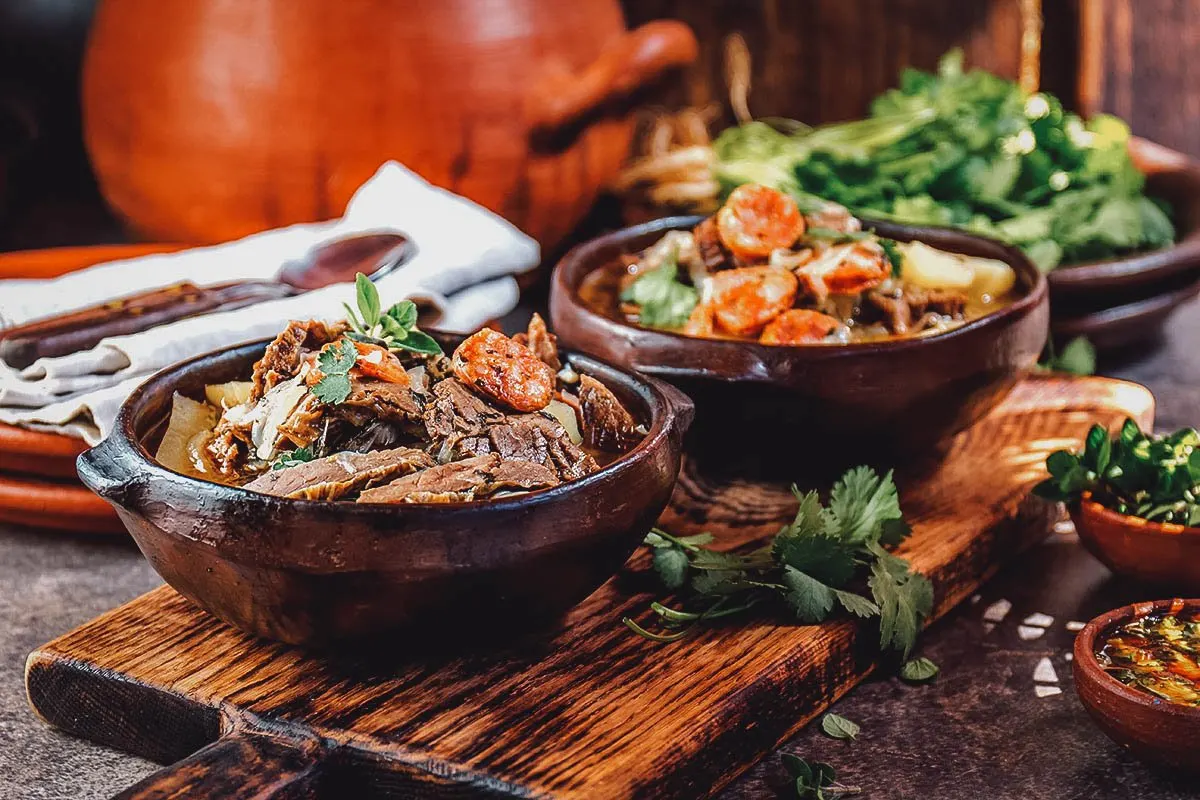
Photo by Blinovita
10. Carbonada
Carbonada is a hearty Chilean stew made with beef, rice, and vegetables like corn, carrots, pumpkin, bell peppers, peas, and red potatoes. It’s seasoned with different herbs and spices like garlic, oregano, paprika, parsley, and cumin.
Chilean carbonada is a thick stew that’s substantial enough to be served as a main dish. Depending on the season, you’ll typically find different vegetables in a carbonada. In the summer, corn and green beans are preferred while in winter, peas and frozen vegetables are often used.
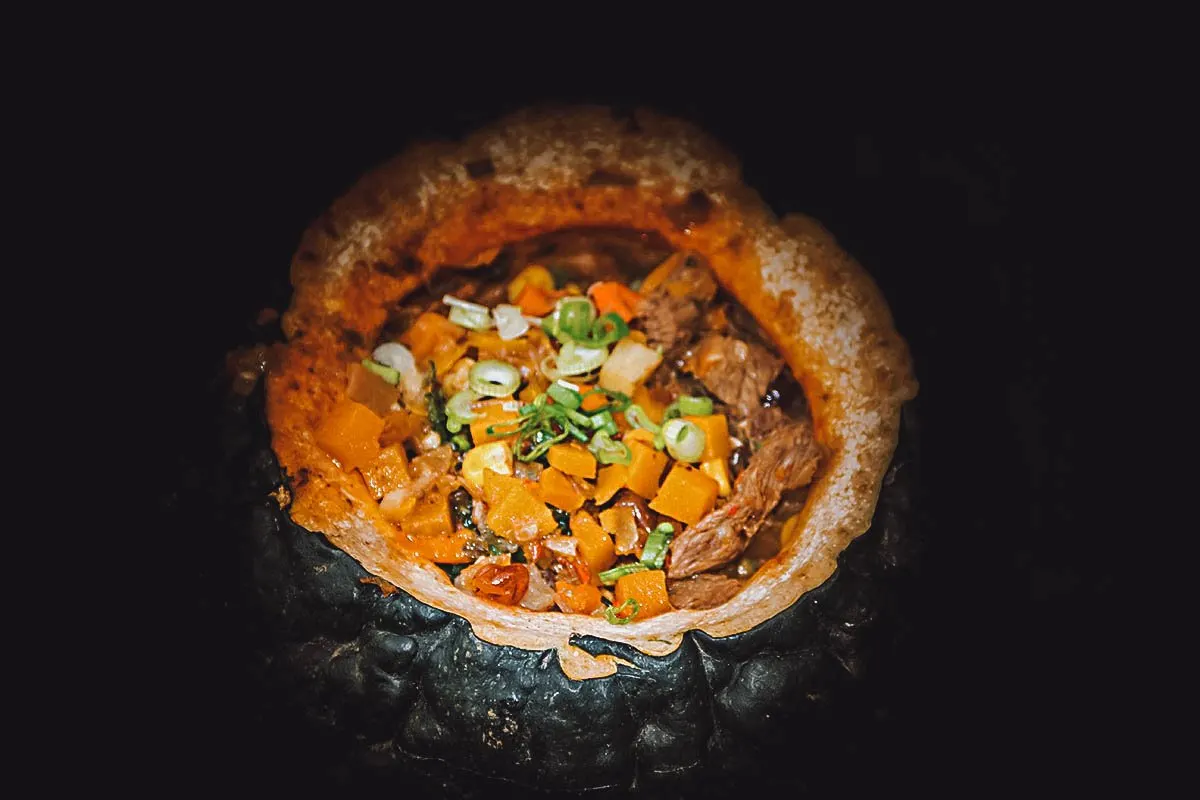
Photo by Wirestock
11. Cazuela
The term cazuela can refer to a traditional Chilean dish and the cooking vessel used to make it. Popular in South American countries like Chile and Peru, cazuela describes a family of soups or stews made with different meats and vegetables cooked together in an unglazed earthenware pot called a cazuela (Spanish for “casserole” or “cooking pot”).
Chilean cazuela can be made with different proteins like pork, goat, lamb, turkey, or llama, but the most popular versions are made with chicken (cazuela de ave) or beef (cazuela de vacuno). It’s made by boiling the meat with chopped onions and carrots in one pot, while the rest of the ingredients are boiled separately in individual pots. Only when the dish is served do all the components come together.
Upon serving, a bowl of cazuela typically includes squash, potatoes, corn, and rice to go with the meat. It’s usually garnished with fresh parsley, coriander, or aji verde (spicy green sauce). After the meal, leftovers are usually saved and used to make carbonada.
Speaking of carbonada, the ingredients in a Chilean cazuela are also known to change with the seasons. In the summer, cazuela de ave (pictured below) usually contains corn, green beans, and peas while winter versions of the dish are often made with the addition of rice or polenta.
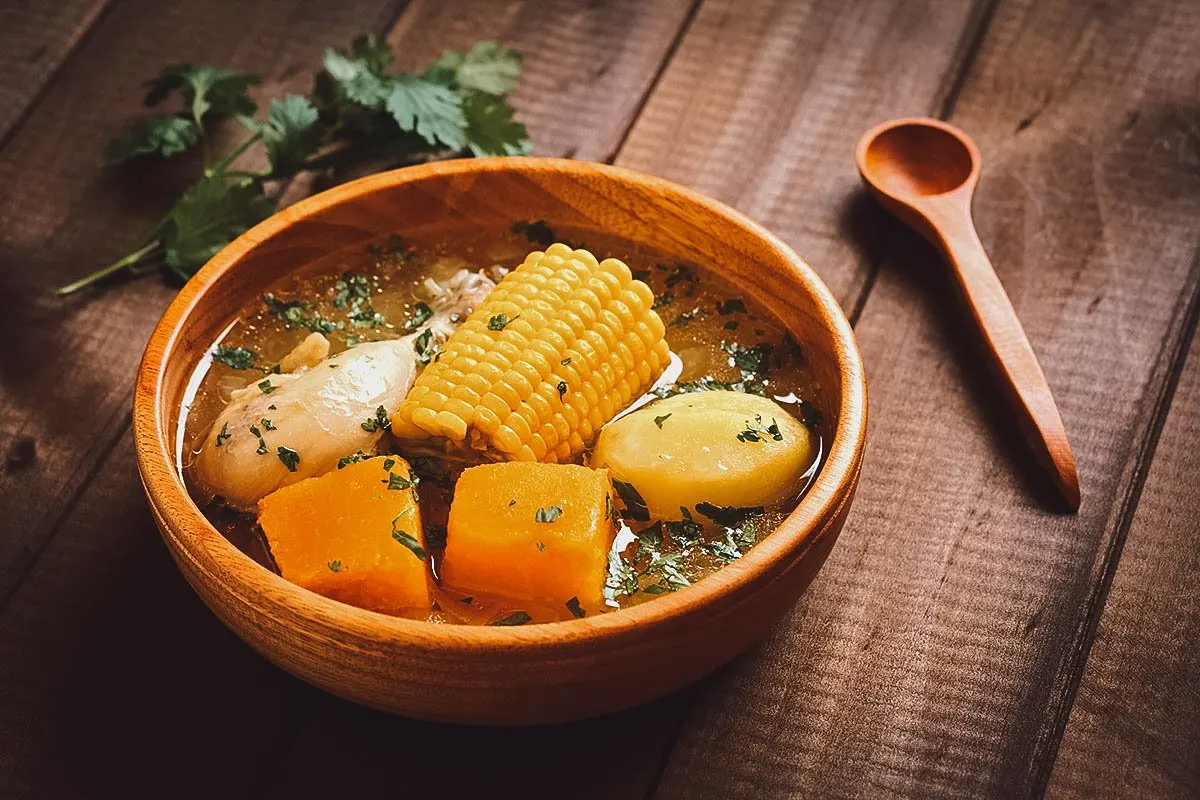
Photo by ildi_papp
Pictured below is cazuela de vacuno, or cazuela made with beef. In the summer, corn, peas, green beans, and tomatoes are often used while in winter, it’s usually made with potatoes, carrots, spinach, or chard. No matter the season, it’s a hearty and filling soup that goes well with crusty bread and pebre salsa.

Photo by PantherMediaSeller
12. Pantrucas
Pantrucas is a simple but filling Chilean soup made with dumplings cooked in a vegetable or beef broth. The dumplings are made with flour, water, and salt and cut into irregular squares before being boiled in the broth.
Pantrucas is popular in winter and can be made with different types of meat like beef, pork, or turkey. Recipes vary from cook to cook but other common ingredients include potatoes, carrots, onions, garlic, and eggs. It’s typically seasoned with oregano, chili, and cumin and garnished with fresh parsley.
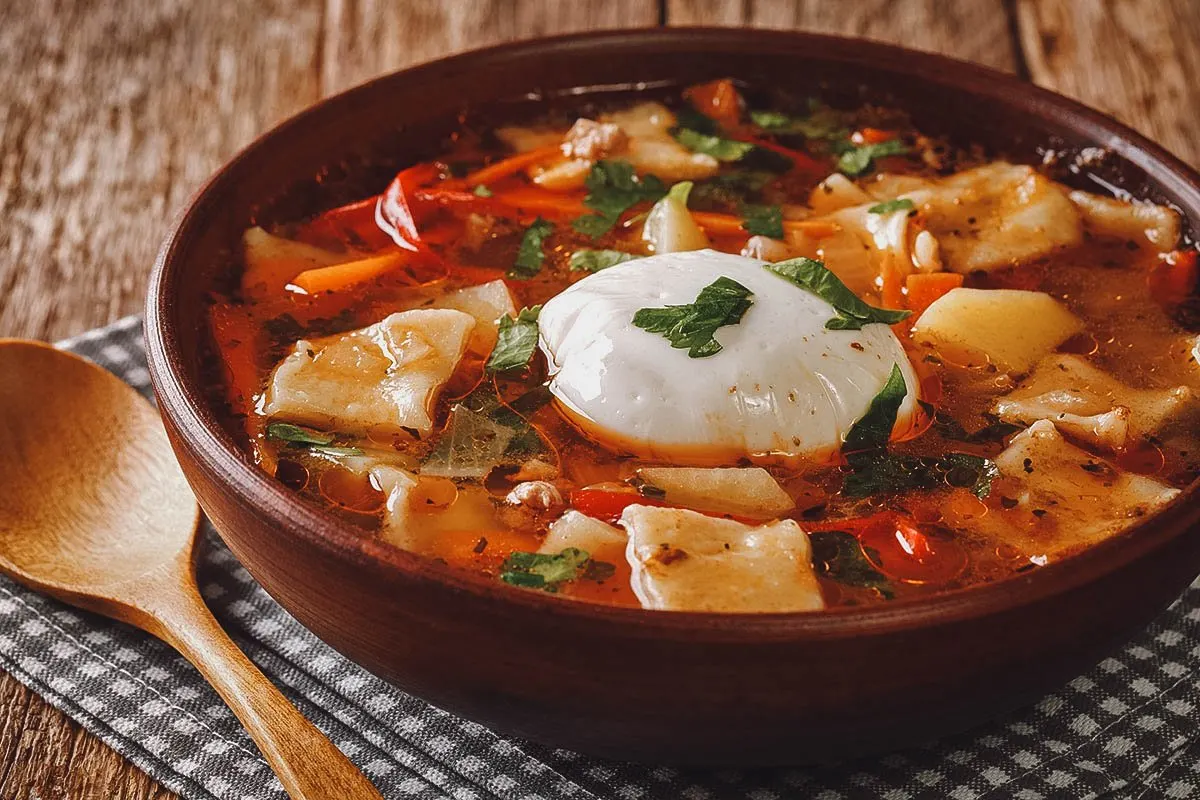
Photo by lenyvavsha
13. Porotos Granados
Porotos means “beans” so porotos granados refers to a thick and hearty stew that’s often consumed in the Chilean countryside. It’s made with ripe cranberry beans, corn, and squash mixed with other ingredients like onions, pumpkin, cumin, basil, and oregano. It’s typically made in the summer to coincide with the harvest of corn and summer squash in central and southern Chile.
Traditionally, porotos granados is made with cranberry beans though they can be substituted with other Chilean beans like tortola, coscorron, or bayo. Vegetable broth is most common though chicken or beef broth can also be used.
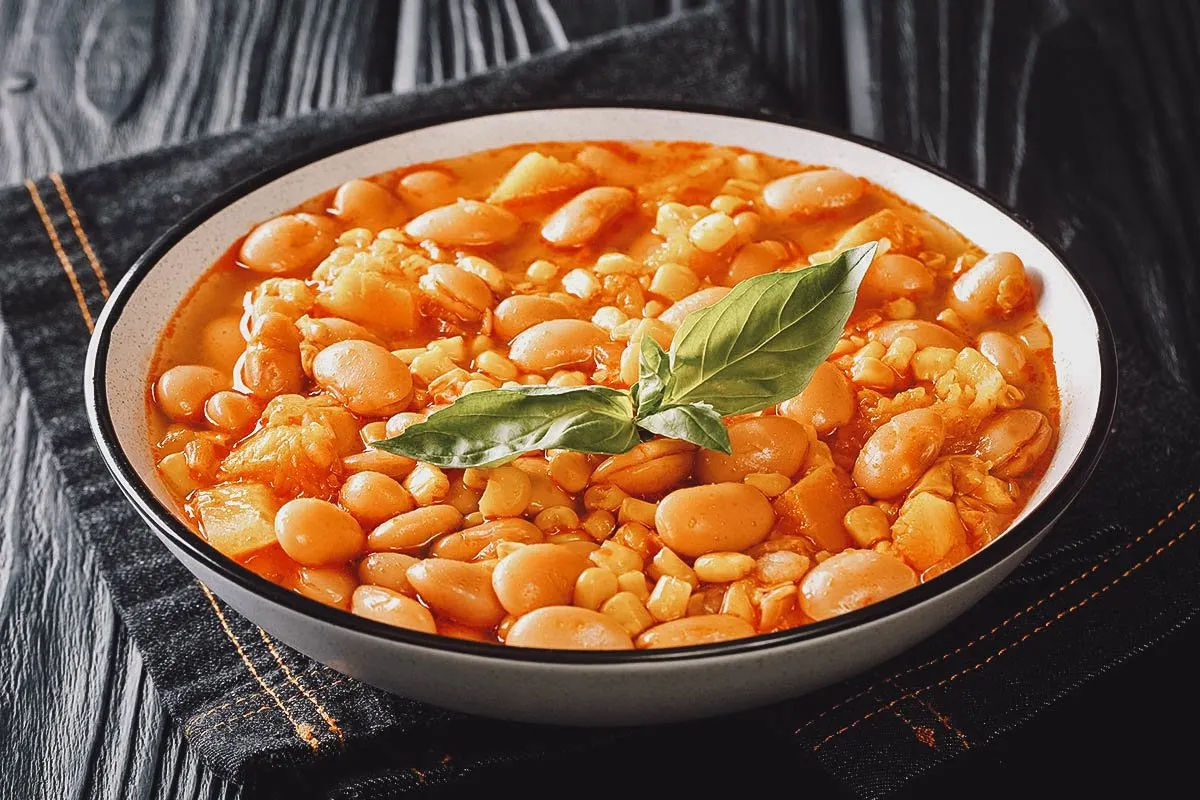
Photo by lenyvavsha
14. Porotos con Riendas
As you can probably tell from its name, porotos con riendas is a traditional Chilean stew made with beans. It’s a popular winter dish consisting of beans cooked with spaghetti, chorizo, squash, onions, garlic, herbs, and spices.
Unlike porotos granados which is traditionally made with a specific type of bean, porotos con riendas can be made with any type of bean like white, navy, or pinto. Its name literally means “beans with reins” and is in reference to the use of spaghetti in the recipe.
Originally, porotos con riendas was made with strips of pork skin. But as the dish grew in popularity and became a staple in Chilean households, the pork was often replaced with strands of cooked spaghetti.
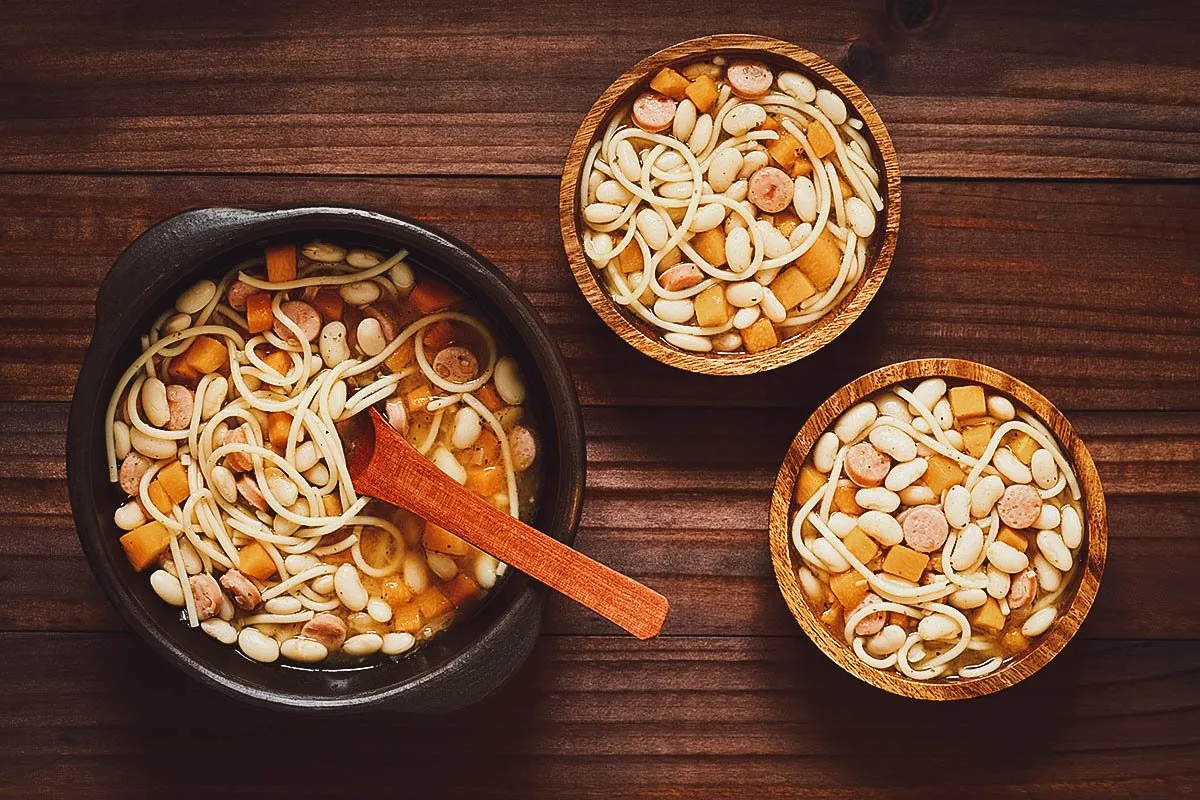
Photo by PantherMediaSeller
15. Caldillo de Congrio
Caldillo de congrio literally means “conger chowder” and refers to a popular Chilean fish soup made with conger eel as its main ingredient. It can be made with either congrio dorado (pink cusk eel) or congrio colorado (red cusk eel), cusk eel species that are common in the Chilean Sea.
To make caldillo de congrio, pieces of chopped and cooked eel are boiled in a pot of water to produce the broth. The broth and eel (and optionally cream) are then added to a sautéed mixture of chopped onions, garlic, bell peppers, carrots, and tomatoes. When ready, the soup is garnished with parsley, coriander, or scallions and traditionally paired with crusty bread and a glass of Chilean wine.
Caldillo de congrio is such a beloved part of Chilean cuisine that Nobel laureate Pablo Neruda famously wrote an ode dedicated to this beloved Chilean soup called “Oda al Caldillo de Congrio“.
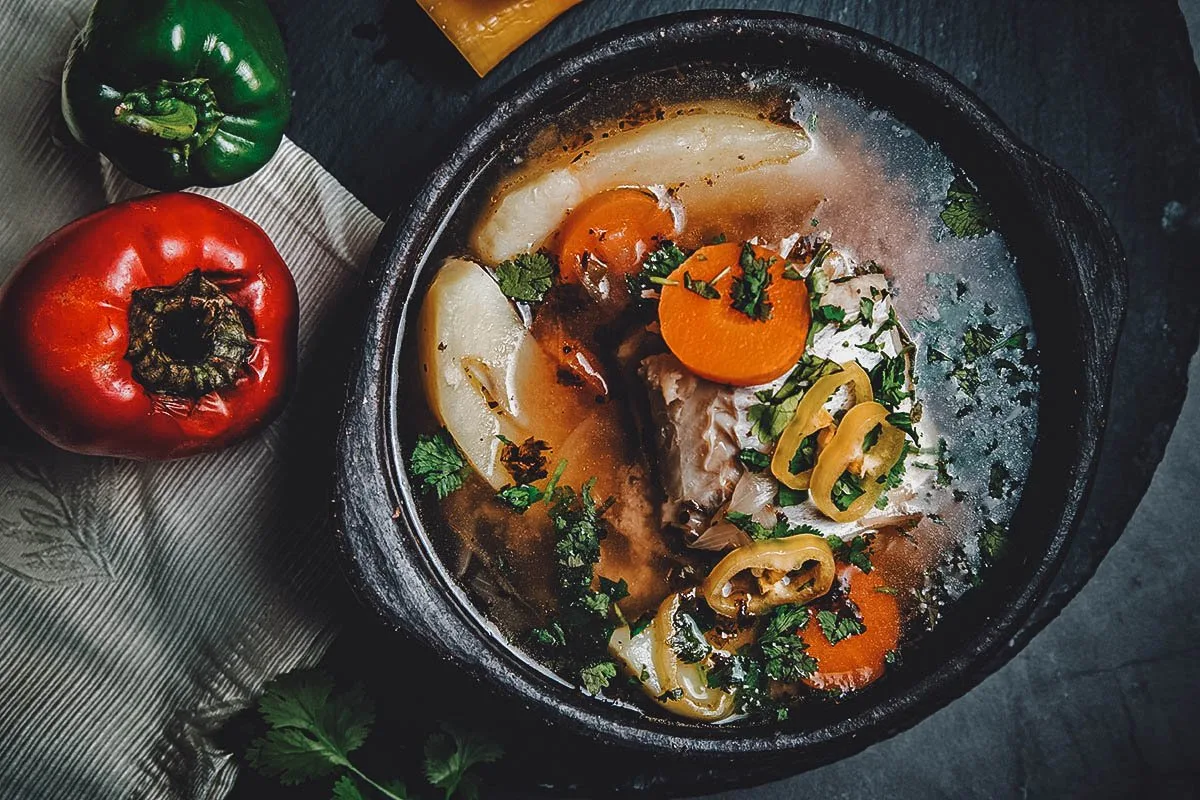
Photo by [email protected]
16. Caldillo de Mariscos
Like caldillo de congrio, caldillo de mariscos refers to a traditional Chilean seafood soup. It can be made with different types of seafood like mussels, fish, shrimp, and squid cooked in a broth with onions, potatoes, white wine, and various herbs and spices like red pepper, paprika, bay leaf, and oregano. It’s typically garnished with fresh parsley and served with a spritz of lemon juice.
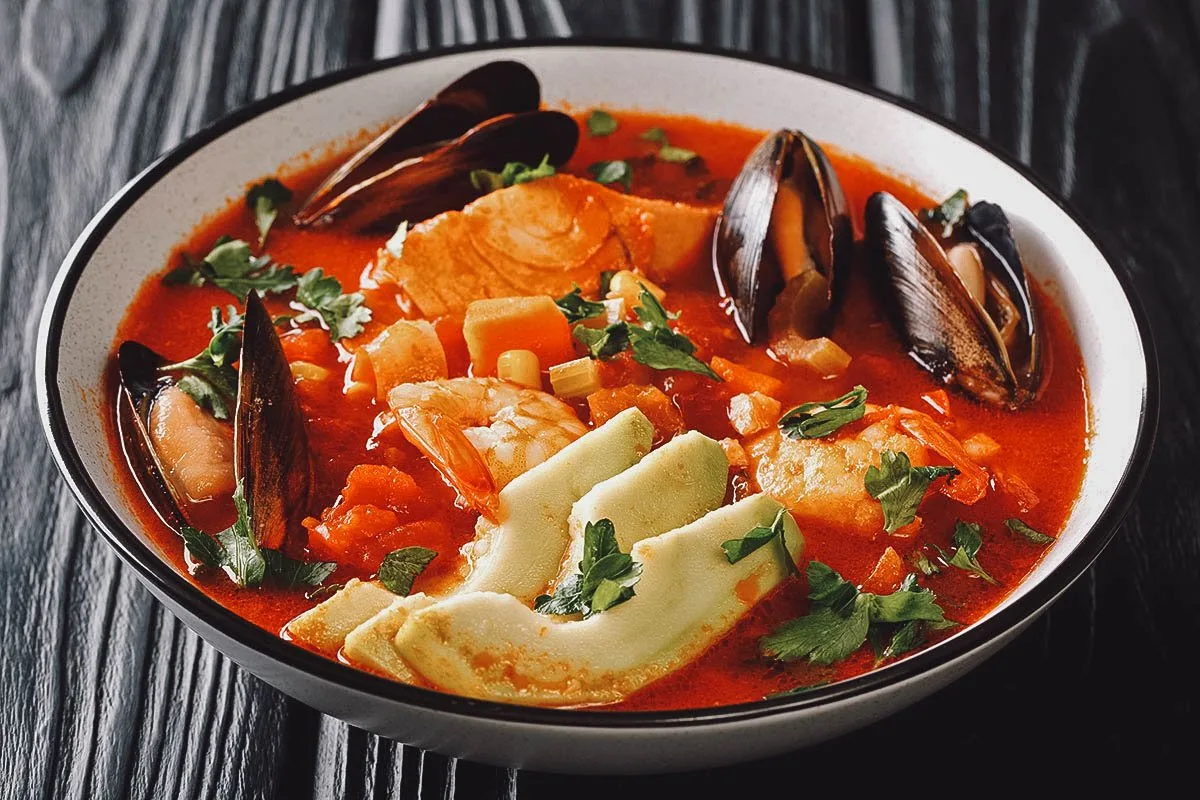
Photo by lenyvavsha
BREAD / PASTRIES / SANDWICHES
17. Marraqueta
Marraqueta is the most popular type of bread in Chilean cuisine. They’re crusty and crunchy like French bread – hence the alternative name pan francés – and known for their distinctive shape and large-ish size that allows them to be easily divided into four segments. It basically looks like four bread rolls merged into one.
Marraqueta is a staple Chilean food that’s consumed everyday in Chile. Also known as pan batido (whipped bread) or pan francés (French bread), they’re often eaten for breakfast, enjoyed with pebre salsa or mashed avocado, or used as sandwich bread.
According to some historians, marraqueta may have originated from Valparaíso sometime in the late 19th and early 20th centuries. During that time, this major port city received thousands of European immigrants, among them two French baker brothers with the surname Teran-Marraquett. They invented this bread which would soon become a staple food throughout Chile.
Today, marraqueta is a cornerstone in Chilean cuisine and culture. Its importance is best illustrated in this popular saying: “Nació con la marraqueta bajo el brazo”. Similar to having a “silver spoon in one’s mouth”, this means “to be born with a marraqueta under his/her arm” and describes a child that has his/her future secured.
Aside from Chile, marraqueta is consumed in many other countries throughout South America like Bolivia, Brazil, Peru, Argentina, and Uruguay. It can also be found in Portugal, Mallorca, Hong Kong, and Macau.
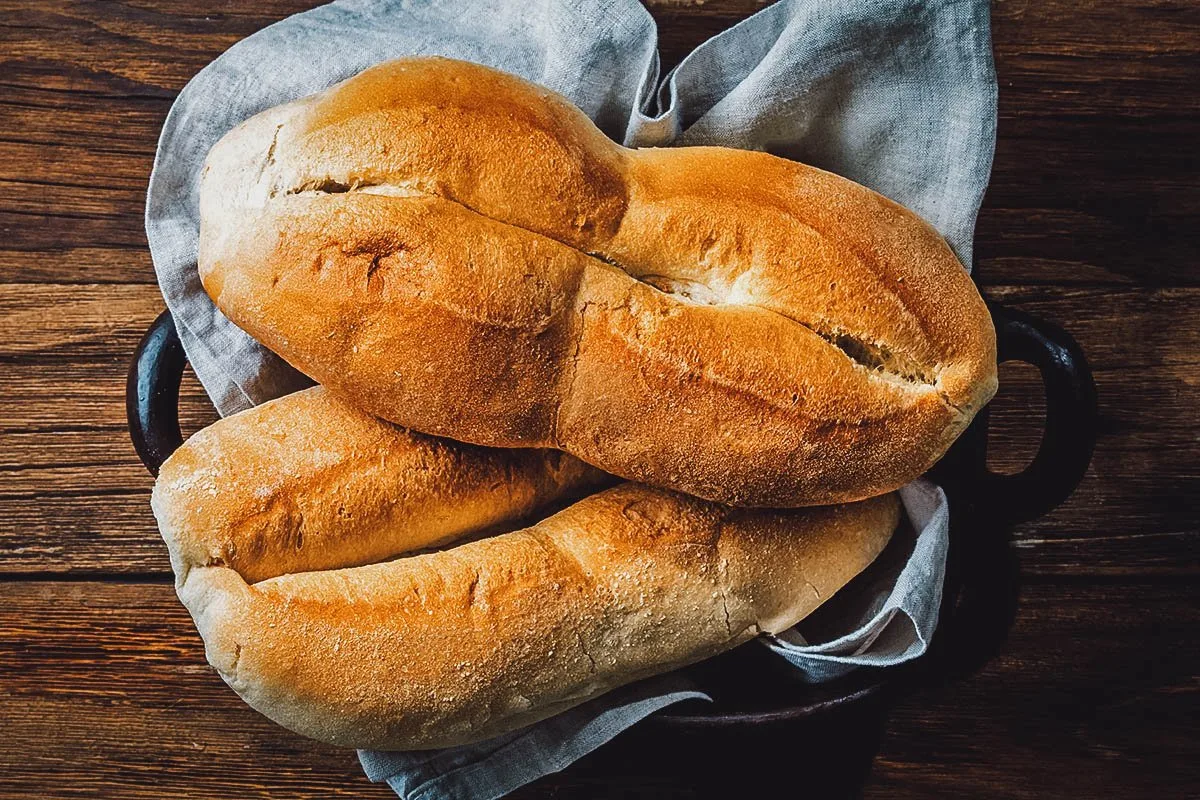
Photo by Blinovita
18. Hallulla
It was interesting to learn that the average Chilean eats over 90 kg (200 pounds) of bread per year, making Chile one of the biggest bread consumers in the world. After marraqueta, hallulla is arguably the second most popular bread in Chile.
Hallulla refers to a simple but rich-tasting Chilean bread made with a dough enriched with lard or vegetable shortening. They’re often used to make sandwiches like chacareros and aliados but they can also be served as a side dish to bigger Chilean meals.
Hallulla is very popular in Chile and also consumed in other South American countries like Bolivia and Ecuador.
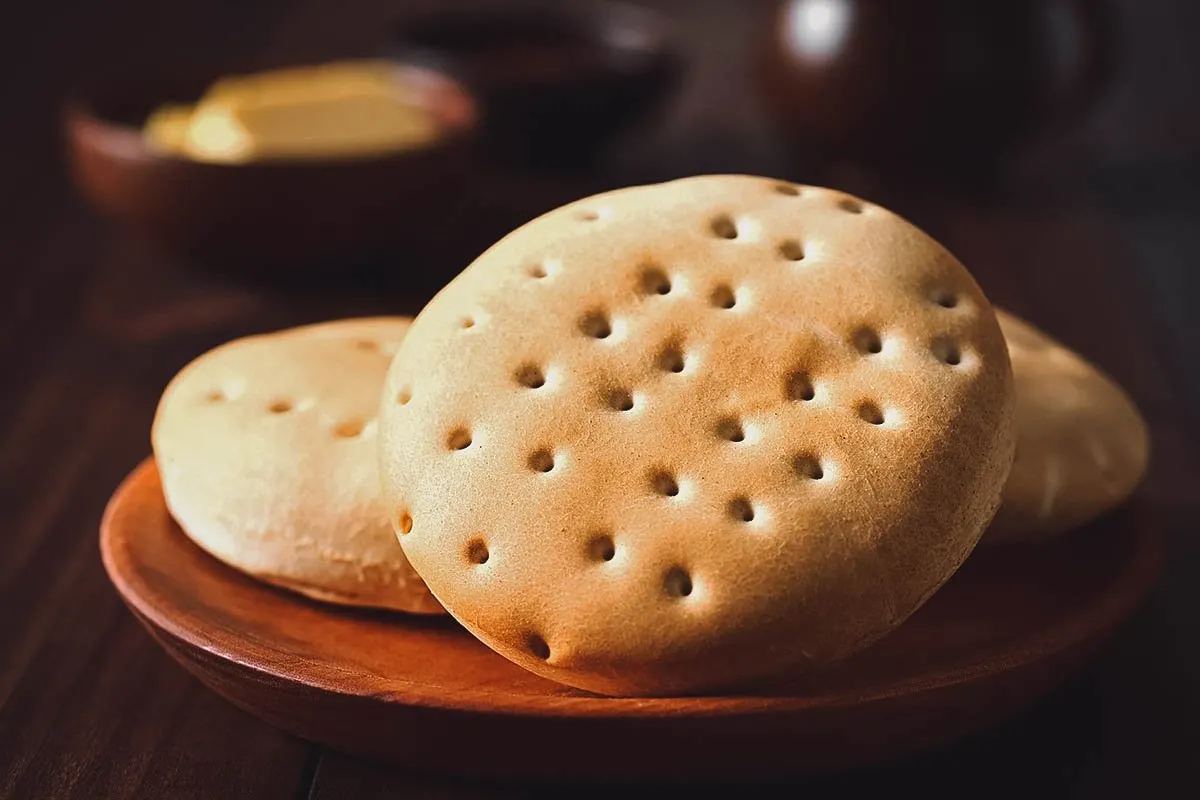
Photo by PantherMediaSeller
19. Pan con Palta
Pan con palta refers to a simple but comforting Chilean dish made with mashed avocado spread over bread, usually marraqueta or hallulla. As far as comfort food goes, you can think of it as the Chilean version of American peanut butter and jelly sandwiches. It’s a Chilean tradition and especially popular with children.
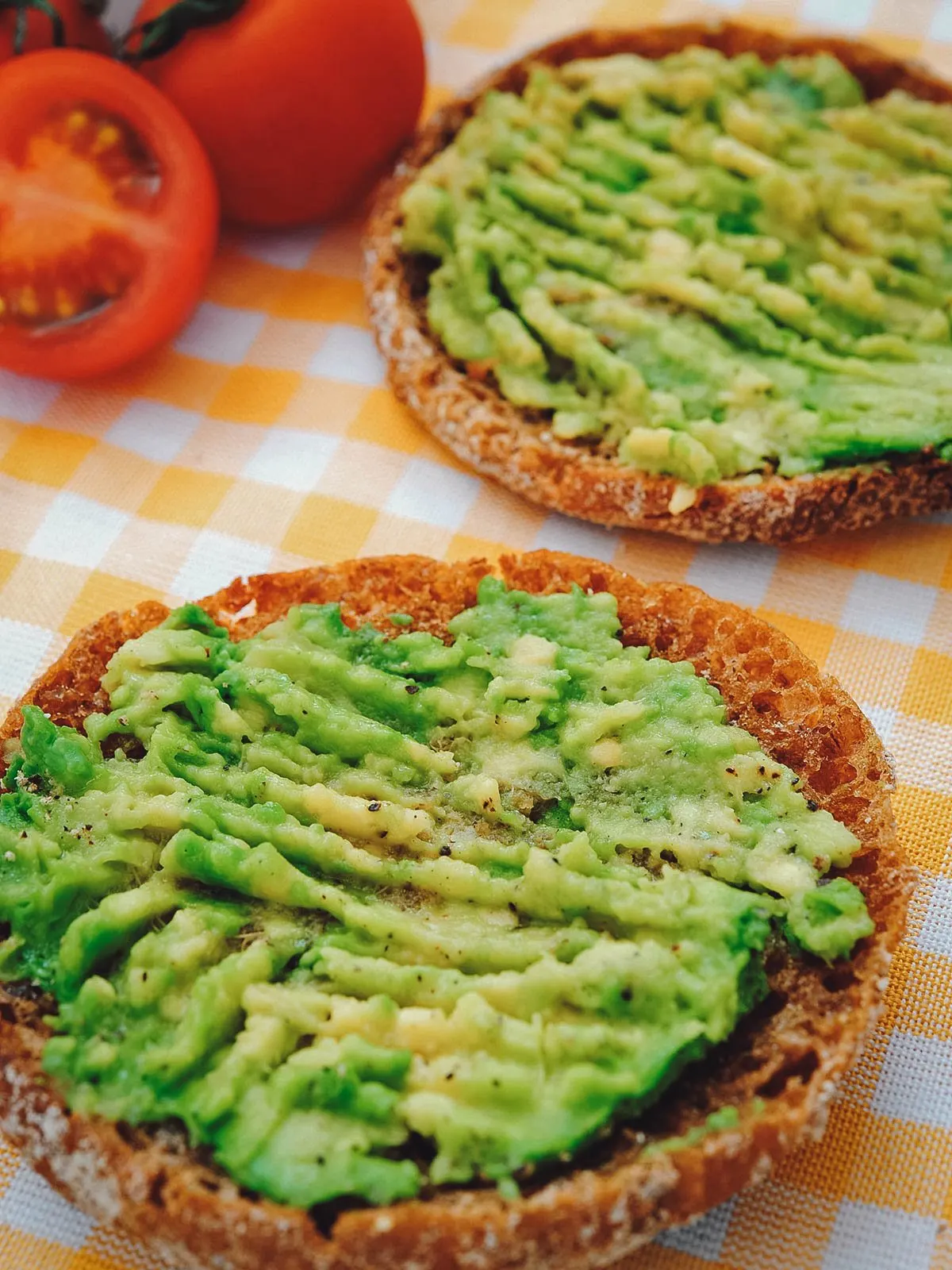
Photo by manams
20. Empanada
The empanada is a hugely popular dish consumed in many former Spanish colonies like Argentina, Venezuela, Belize, Costa Rica, Peru, Puerto Rico, and the Philippines. In Chile, it’s considered by many to be a national dish.
If you’ve never had one, an empanada is a baked or fried turnover pastry filled with a variety of savory ingredients like meat, corn, tomatoes, and cheese. Originally from Spain, its name stems from the Spanish word empanar which means “to bread” or “to wrap something in bread”.
Empanadas exist in countless variations and can vary in size, shape, and filling. They’re typically small in size and consumed as a snack but in Latin America, some are big enough to be eaten as a main meal. In Chile, among the most popular are empanadas de pino. It refers to a large Chilean empanada generously filled with minced beef, onions, olives, raisins, and hard-boiled eggs.
Though many people think of empanadas as savory sancks, they can be made with sweet fillings as well. Some of the most popular sweet Chilean empanadas include empanadas de pera (pear) and empanadas de manzana (apple).
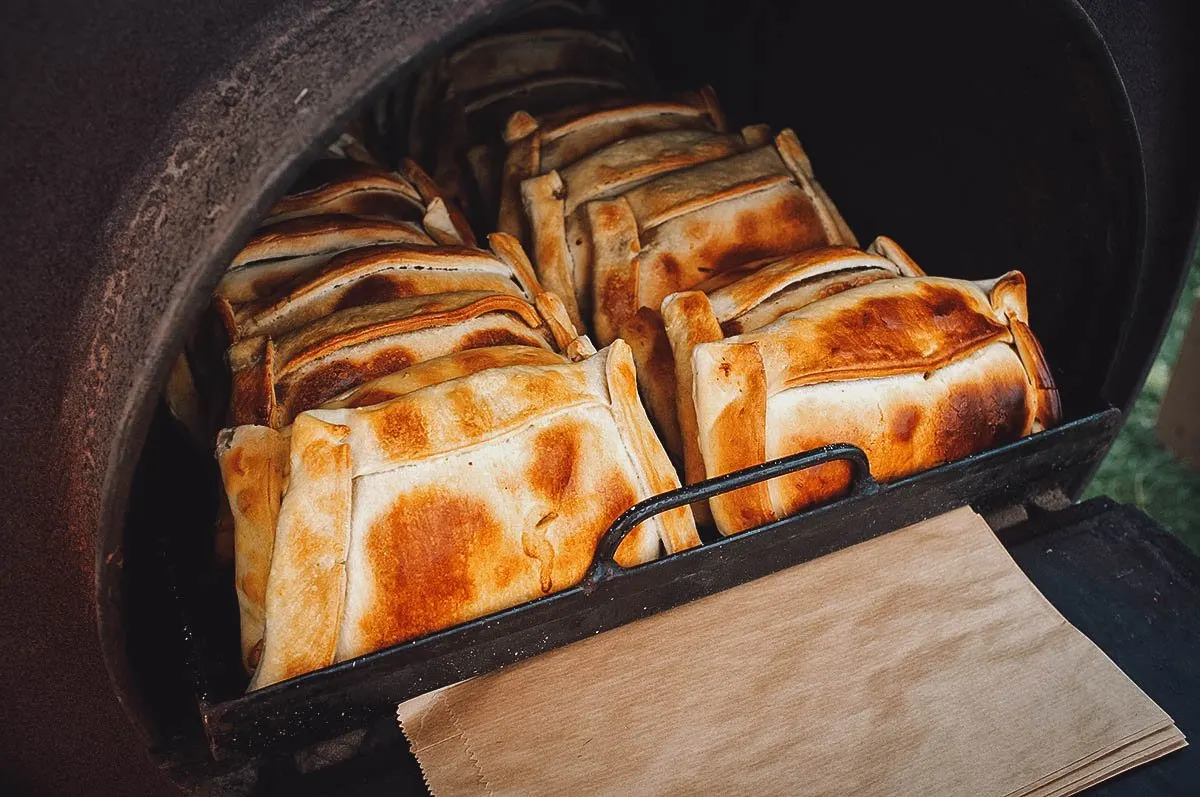
Photo by marcelo
21. Sopaipilla
A sopaipilla (or sopapilla, sopaipa, cachanga) is a type of fried pastry or bread popular in many South American countries like Chile, Argentina, Peru, and Uruguay. They’ve been a Chilean tradition since the 18th century, often made at home or sold as street food.
Sopaipilla varies from country to country but the Chilean version consists of round and flat pieces of leavened wheat dough enriched with vegetable shortening (or butter) and cooked ground pumpkin. The dough is allowed to rise before being rolled out and cut into circular shapes. They’re then deep-fried in oil which causes them to puff up and form a hollow pocket in the center.
Chilean sopaipillas can be savory or sweet and enjoyed with various condiments like pebre salsa, ketchup, mustard, avocado, jam, honey, butter, or cheese. A variation of the dish called sopaipillas pasadas can also be made by boiling them in chancaca sauce, a type of homemade syrup made with panela (unrefined whole cane sugar), cinnamon, and orange peel.
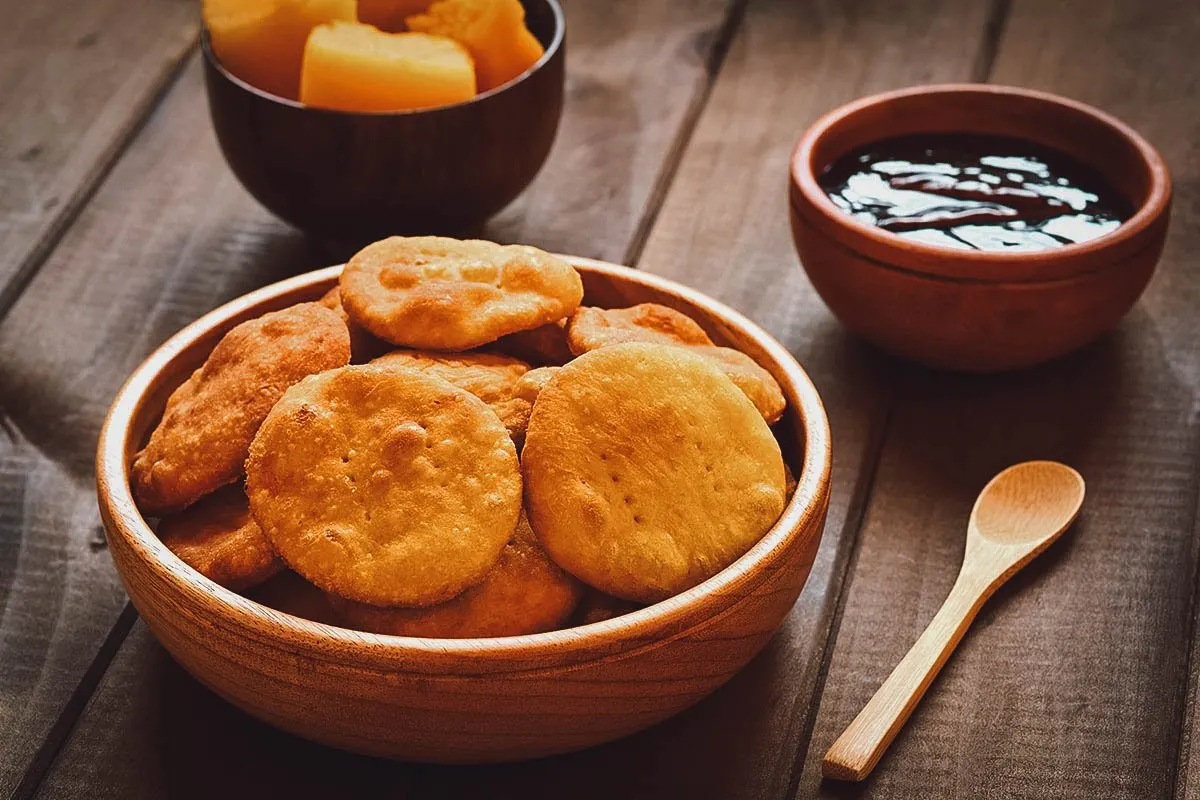
Photo by ildi_papp
22. Churrasco Italiano
Churrasco italiano refers to a messy but delicious sandwich made with slices of steak, tomatoes, mayonnaise, and mashed avocado. The sandwich is Chilean in origin but it gets the “Italiano” in its name from the color of its ingredients. They’re said to represent the Italian flag – mashed avocados for green, mayonnaise for white, and tomatoes for red.
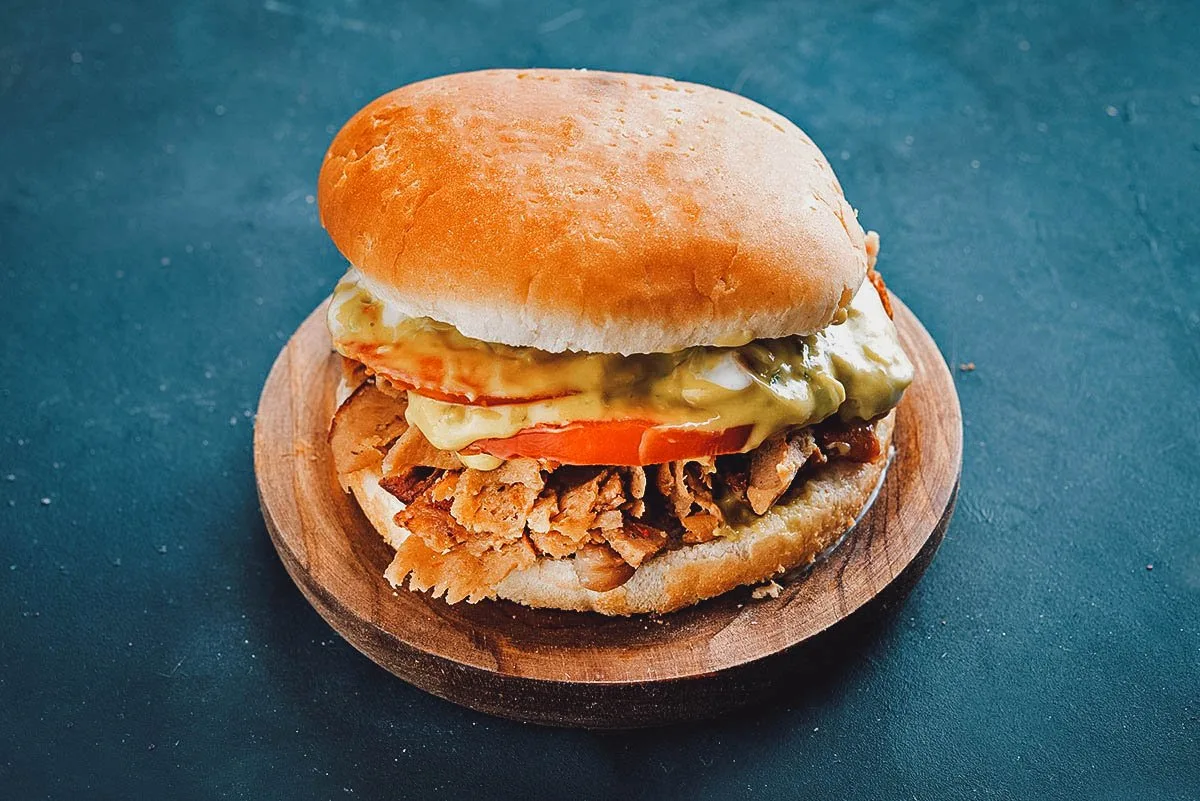
Photo by Dalaifood
23. Completo
If you like American comfort food, then you’re going to enjoy completo, the Chilean version of the famous hot dog. It’s one of the most popular street foods in Chile and can be made in dozens of variations, some of the most popular being the italiano, clasico, and dinámico.
The completo was introduced to Chile in the 1920s by Eduardo Bahamondes, a Chilean national who got his first taste of American-style hot dog on a business trip to the US. He wanted to introduce it to the Chilean people so he opened a restaurant called Quick Lunch Bahamondes in Santiago’s historic center shortly after returning to Chile.
Pictured below is the traditional completo or completo clasico. It’s made with a boiled wiener sausage served in a soft bread roll topped with chopped tomatoes, sauerkraut, and a generous helping of mayonnaise.

Photo by ildi_papp
The most popular type of Chilean hot dog is the completo italiano (pictured below). Like churrasco italiano, it gets its name from the color of its ingredients – mashed avocados for green, mayonnaise for white, and tomatoes for red. In addition to these three toppings, many Chileans will often add ketchup, mustard, or hot sauce to their completo italiano.
Aside from the clasico and italiano, be sure to these other popular versions of completo in Chile:
Completo Dinámico: Topped with chopped tomatoes, sauerkraut, avocado, and a green sauce made from chopped parsley, mayonnaise and a carrot, onion and pickle relish.
Completo Gringo: Topped with tomatoes, pickles, lettuce, onions, and mayonnaise.
Completo el Brasileño: Topped with melted cheese and avocado.
Completo Falso: Vegetarian version made without the sausage.
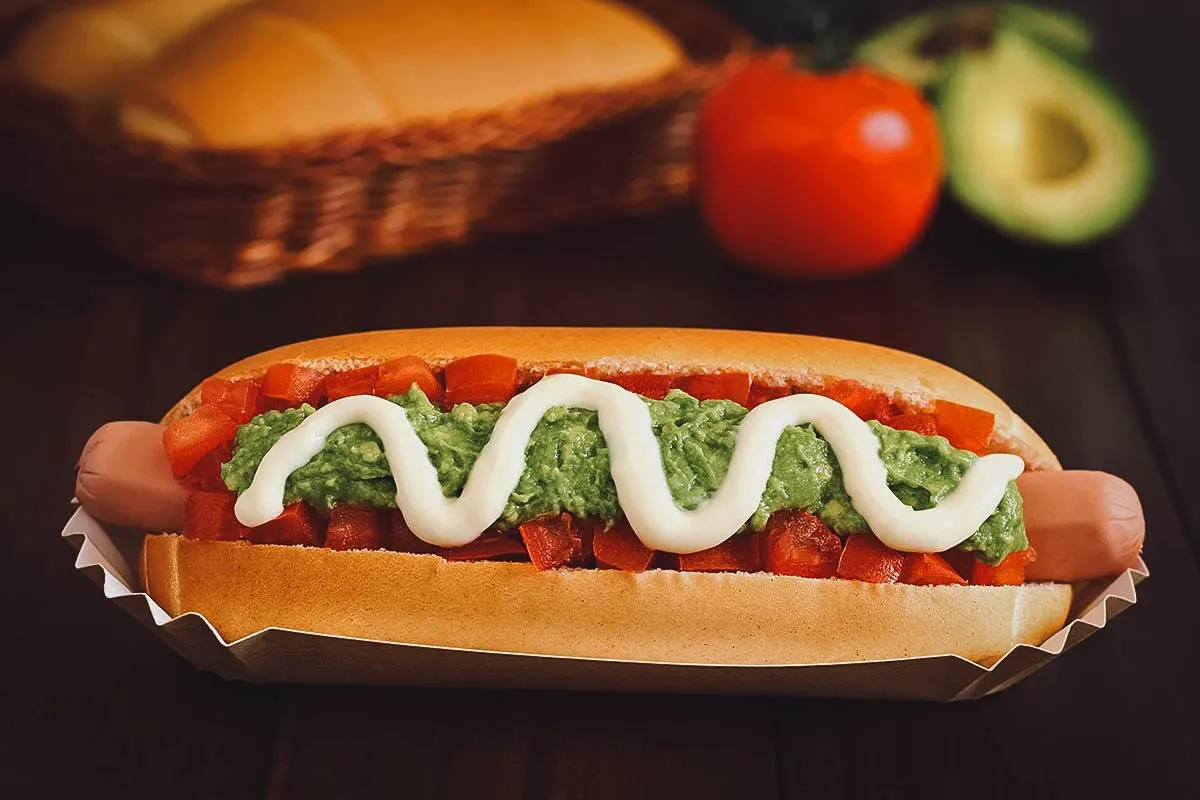
Photo by PantherMediaSeller
24. Choripán
The choripán is a type of sausage sandwich popular in many countries throughout Latin America like Chile, Argentina, Bolivia, Peru, Uruguay, and El Salvador. It consists of a grilled sausage served in a crusty bread bun.
Choripán is typically made with chorizo but in Chile, it’s made with longaniza. It’s traditionally served in marraqueta and topped with pebre salsa, mayonnaise, and aji pepper sauce.
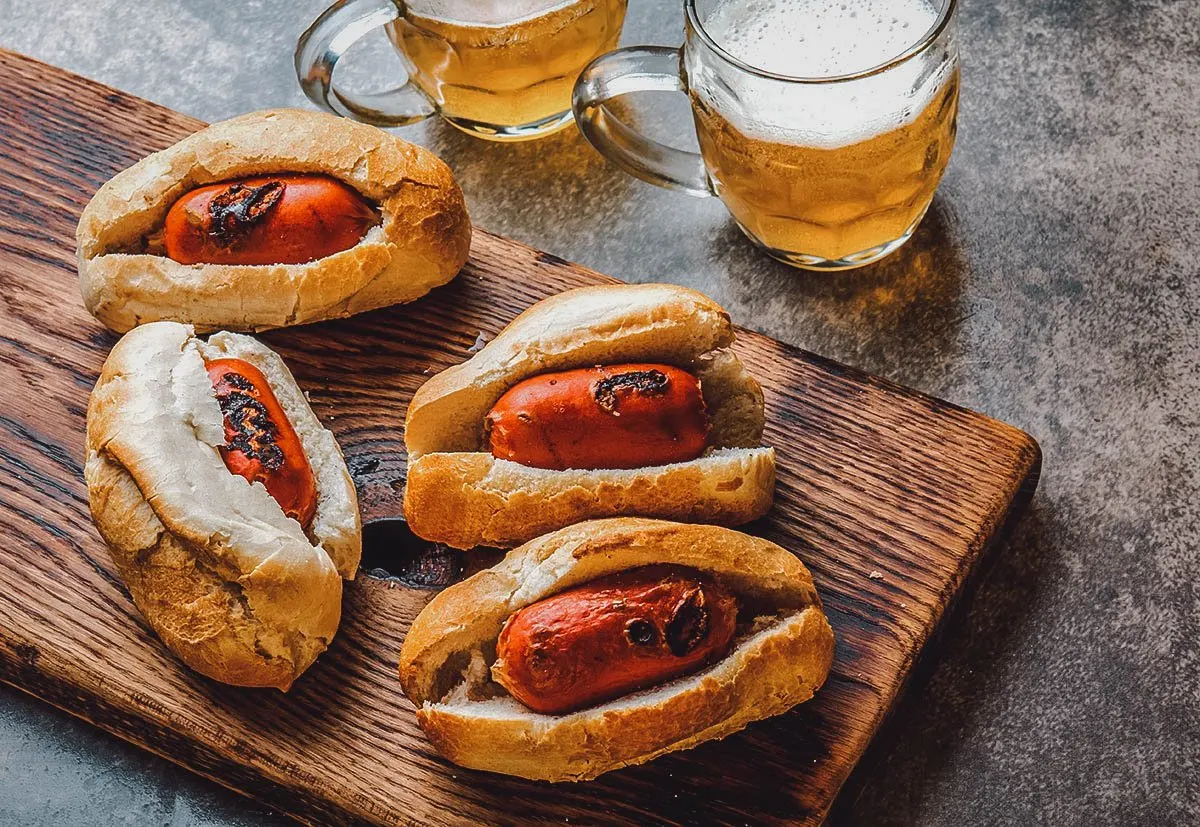
Photo by Blinovita
MEAT / POULTRY / SEAFOOD
25. Pastel de Choclo
Like the empanada, pastel de choclo is a Chilean national dish and one of the most representative of the cuisine. It refers to a type of corn pie made with a sweet corn or choclo topping covering a mixture of ground beef, chicken, black olives, onions, raisins, and hard-boiled eggs.
To make pastel de choclo, sweet corn is ground into a paste and mixed with chopped basil before being pre-cooked with milk and a bit of lard. It’s then poured over the ground beef mixture in a traditional clay pot before being baked in an oven. As it cooks, the corn layer caramelizes and creates a salty-sweet combination that’s reminiscent of shepherd’s pie.
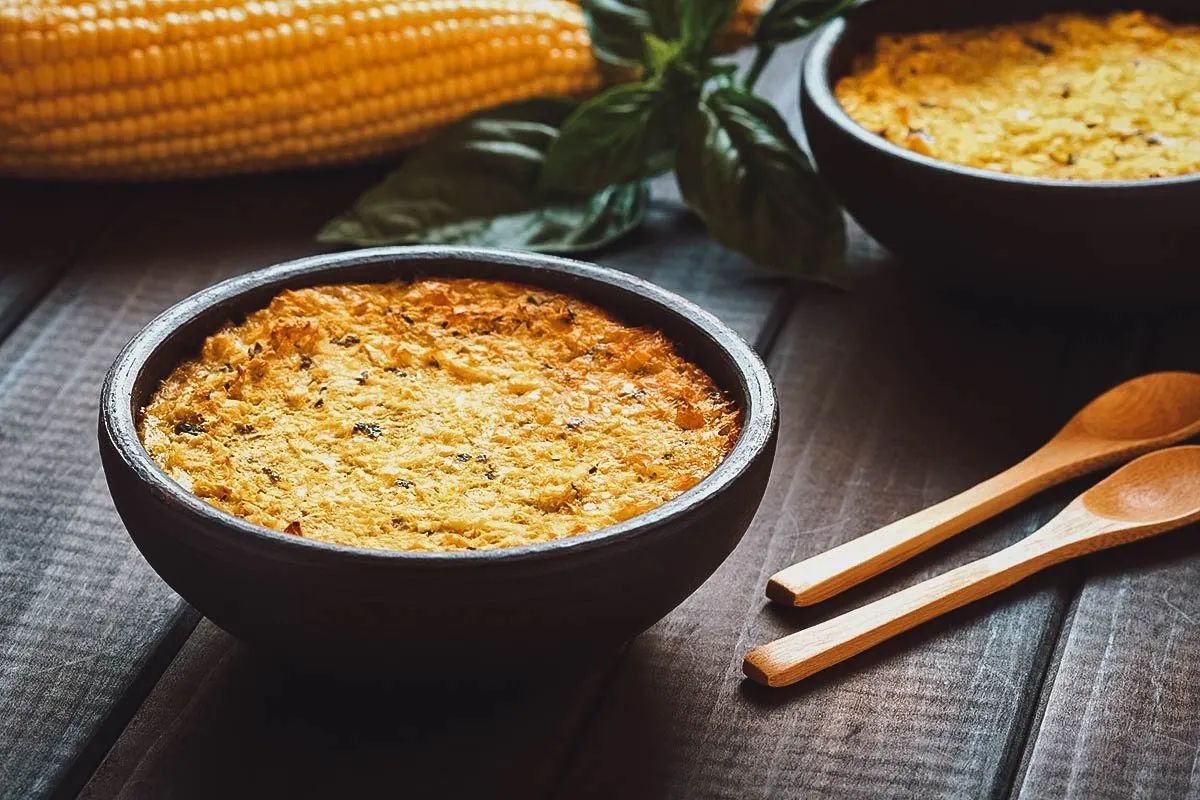
Photo by ildi_papp
26. Lomo a lo Pobre
Lomo a lo pobre (or bistec a lo pobre, bife a lo pobre) refers to a dish of beef tenderloin served with fried eggs, french fries, and fried onions. Popular in Chile and Peru, it’s basically the South American equivalent to American steak and eggs, but instead of being eaten for breakfast, it’s typically consumed for lunch or dinner.
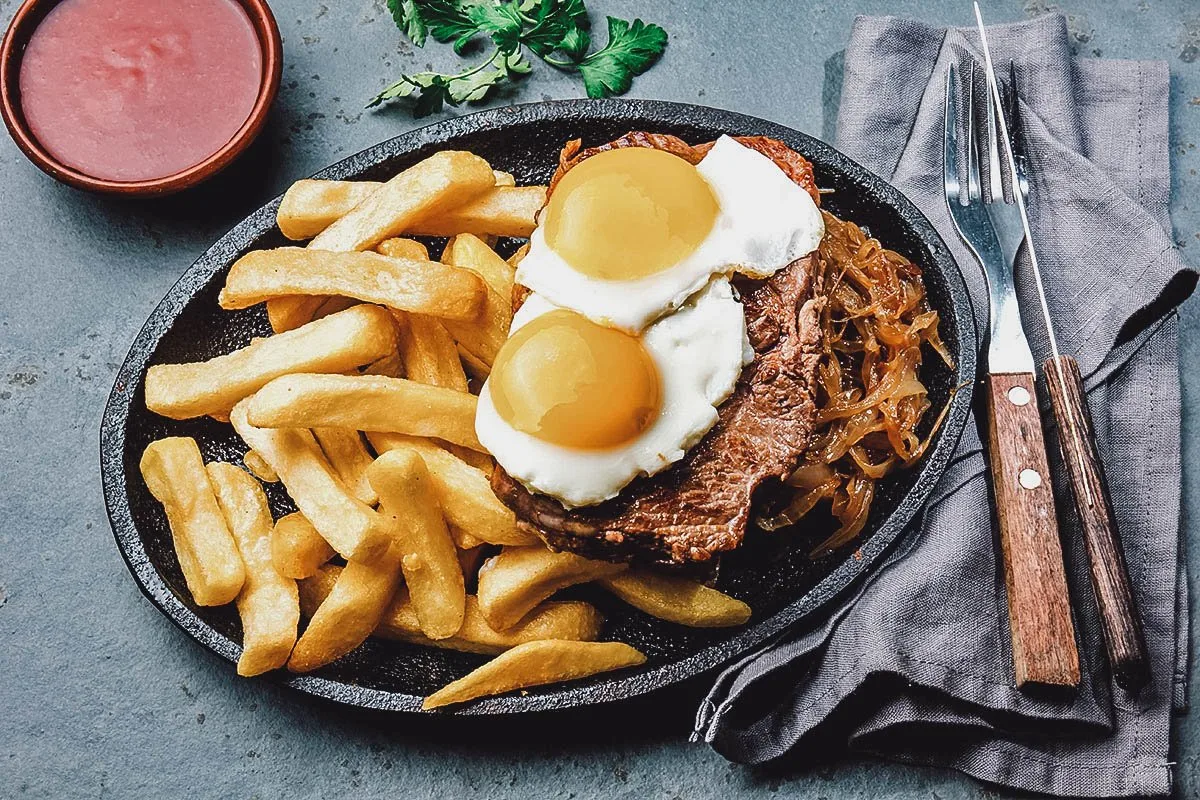
Photo by Blinovita
27. Chorrillana
Chorrillana is a dish that’s very similar to lomo a lo pobre. It consists of beef served with french fries, caramelized onions, and fried eggs. But unlike lomo a lo pobre which is served with beef tenderloin, chorrillana can be made with a mix of cheaper cuts of beef and sausages.
Chorrillana is a popular comfort food in Chile and almost always served in hefty portions for sharing, often with beer. Made with a base of french fries and beef, it varies from restaurant to restaurant and can be served with different ingredients like scrambled eggs, frankfurter sausages, chorizo, and tomatoes.
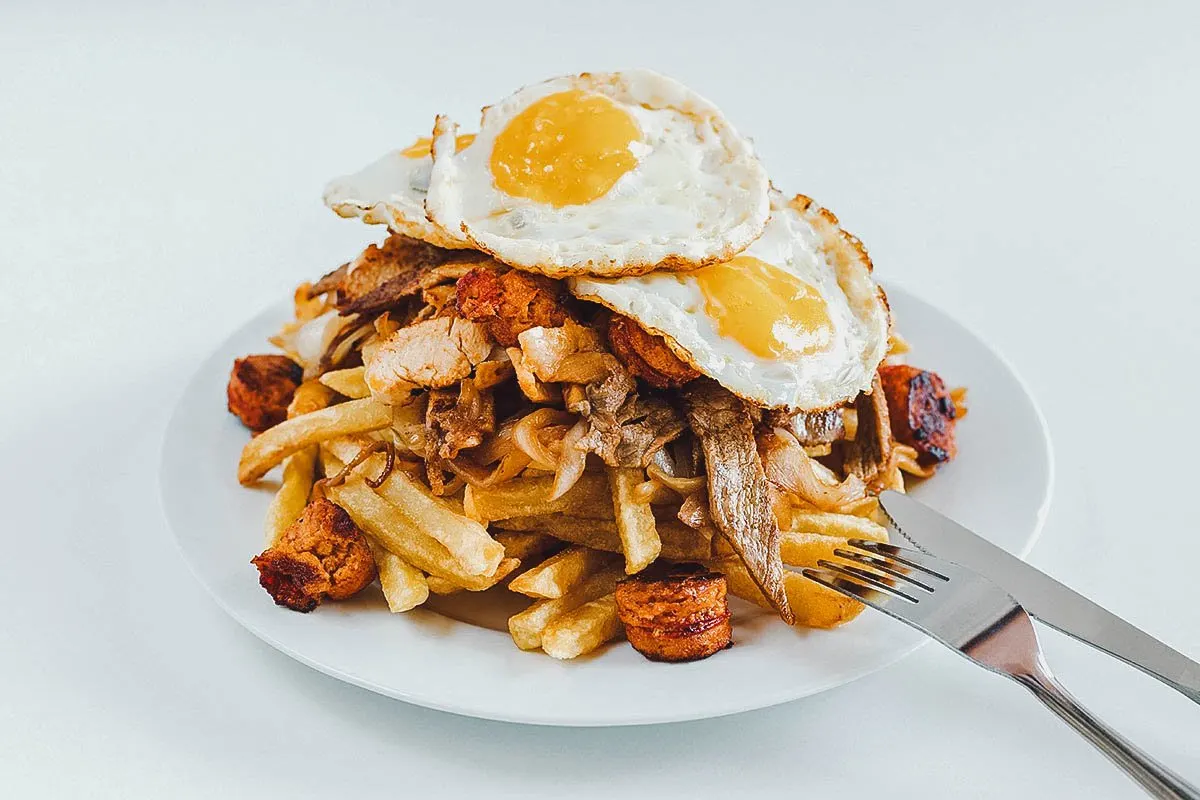
Photo by JuanPonceH
28. Salchipapa
The name salchipapa is a portmanteau word for salchicha (sausage) and papa (potatoes) and refers to a popular Latin American street food dish made with pan-fried beef sausages and fries. It’s originally from Lima, Peru but has become popular in many countries throughout Latin America like Chile, Argentina, Bolivia, Ecudaor, and Colombia.
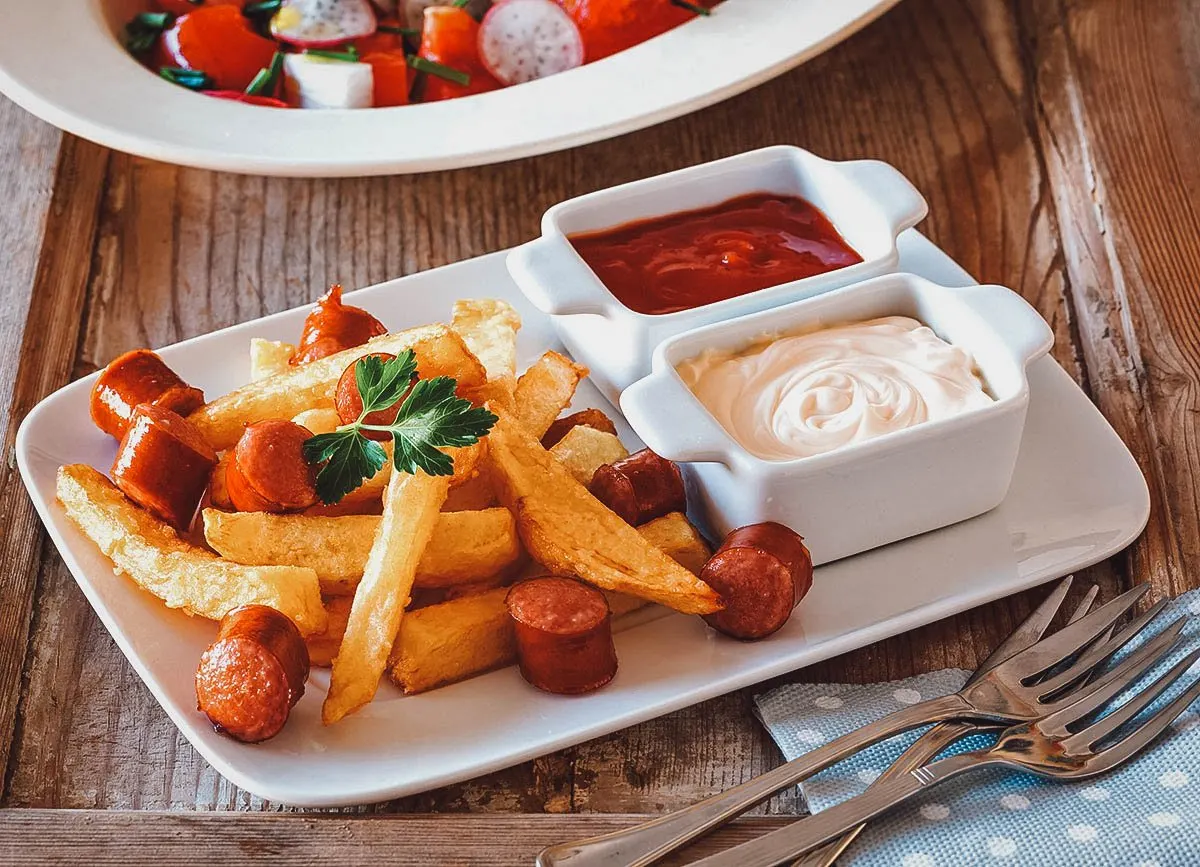
Photo by hansgeel
29. Costillar de Chancho
Costillar de chancho refers to South American pork ribs. Unlike beef ribs that are typically seasoned with just salt, costillar de chancho is marinated for several hours in a mixture of garlic, ground pepper, sweet paprika, cumin, oregano, olive oil, and red wine vinegar before being slow-roasted in an oven or grill.
In winter, costillar de chancho is traditionally served with spicy mashed potatoes but in summer, salads are generally preferred.
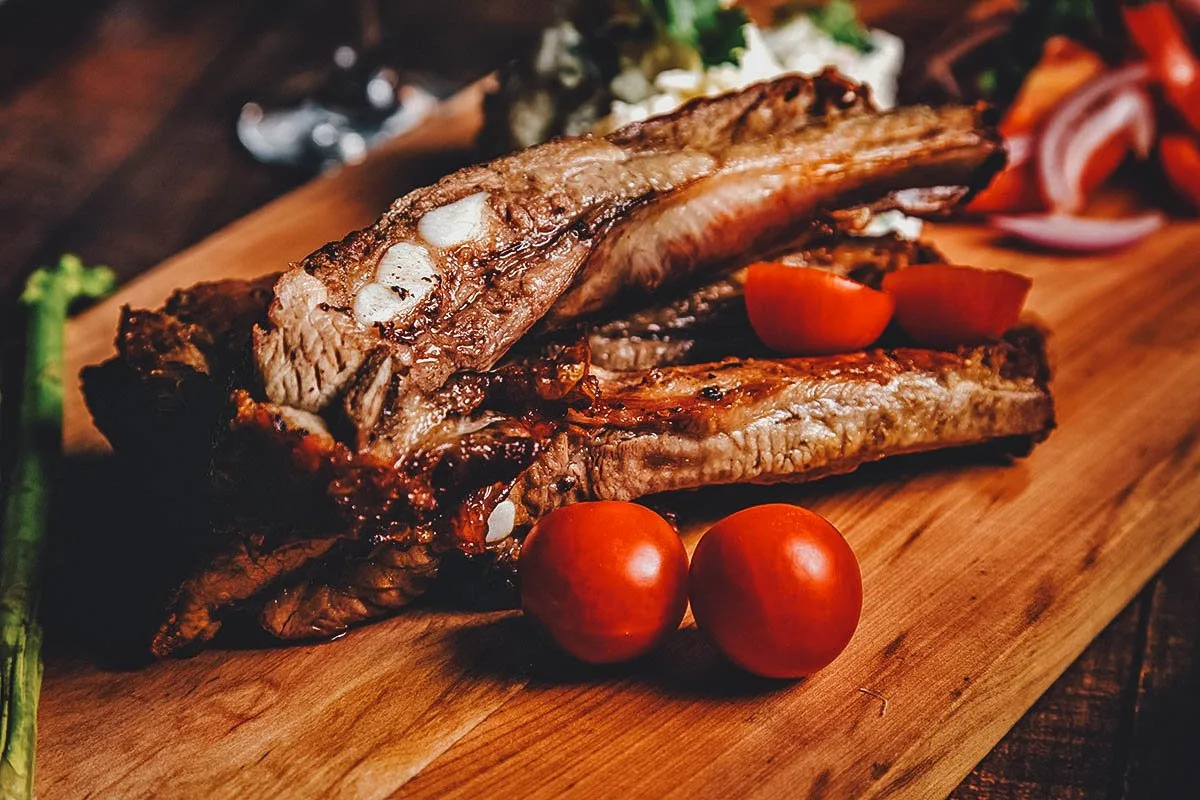
Photo by [email protected]
30. Prietas con Papas Cocidas
Prietas con papas cocidas refers to a simple but hearty Chilean dish made with prietas, boiled potatoes, and caramelized onions. The prieta is a type of Chilean blood sausage made with pig’s blood, chopped onions, spices, and other ingredients.
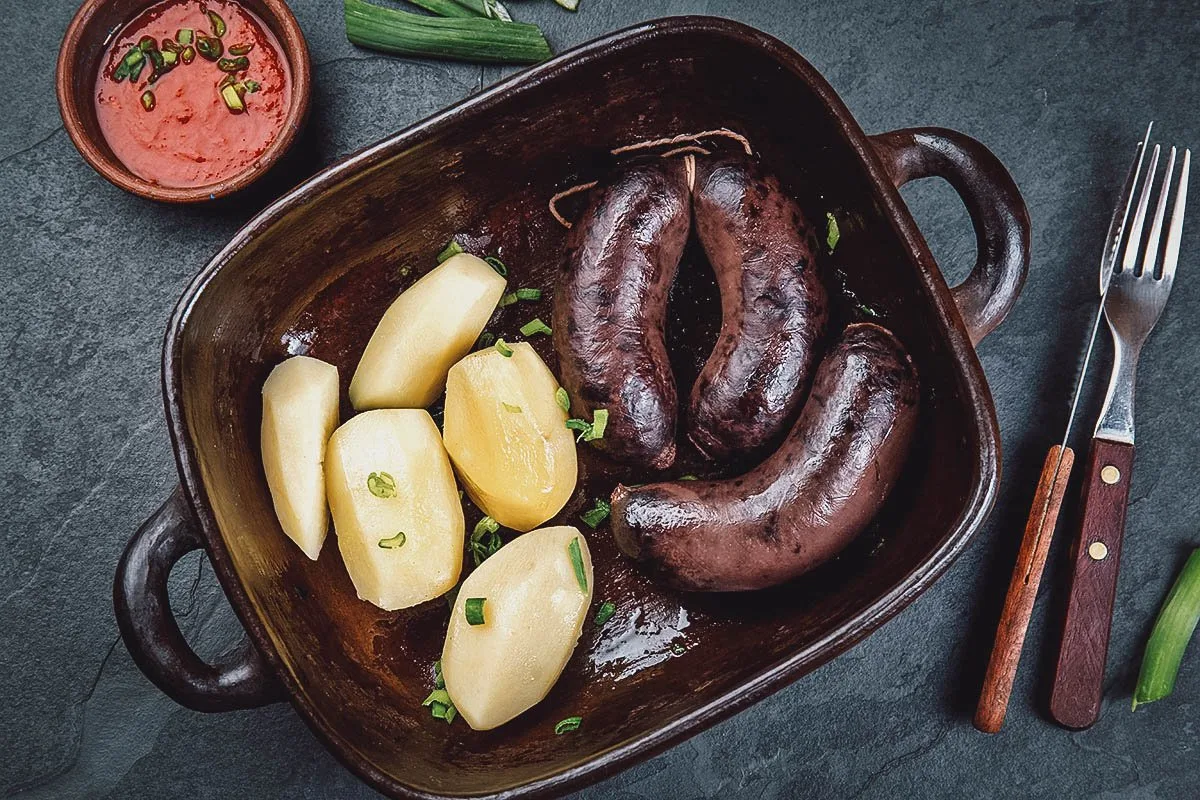
Photo by Blinovita
31. Pollo Arvejado
Pollo arvejado is a classic Chilean dish made with chicken and peas stewed in chicken stock with garlic, onions, carrots, green peppers, and bay leaves. It’s a popular and easy-to-make dish that’s traditionally paired with steamed white rice or potatoes.
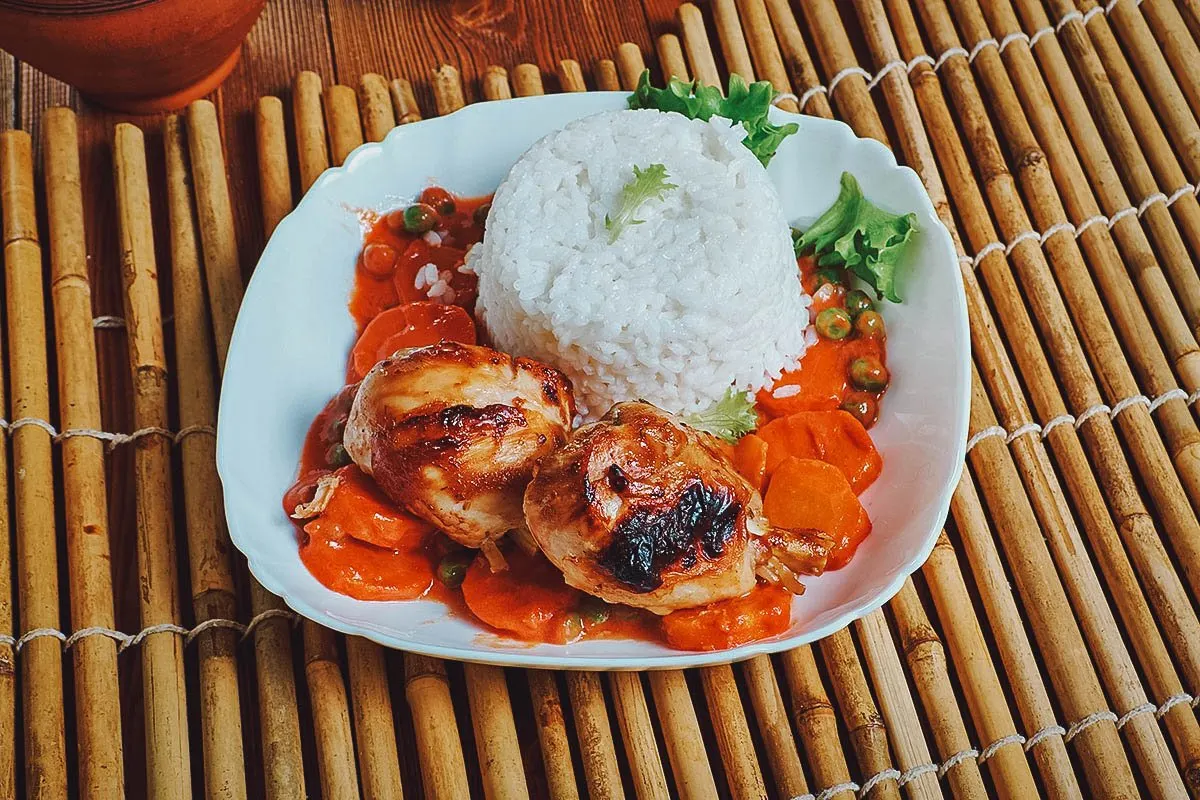
Photo by fanfon
32. Pastel de Jaiba
If you love crab, then you need to try pastel de jaiba. It refers to a rich crab pie or casserole made with stone crab meat mixed with bread, garlic, onions, milk, cream, breadcrumbs, white wine, and spices. Like pastel de choclo, it’s traditionally baked in shallow clay pots and served with grated cheese and a side of crusty bread.
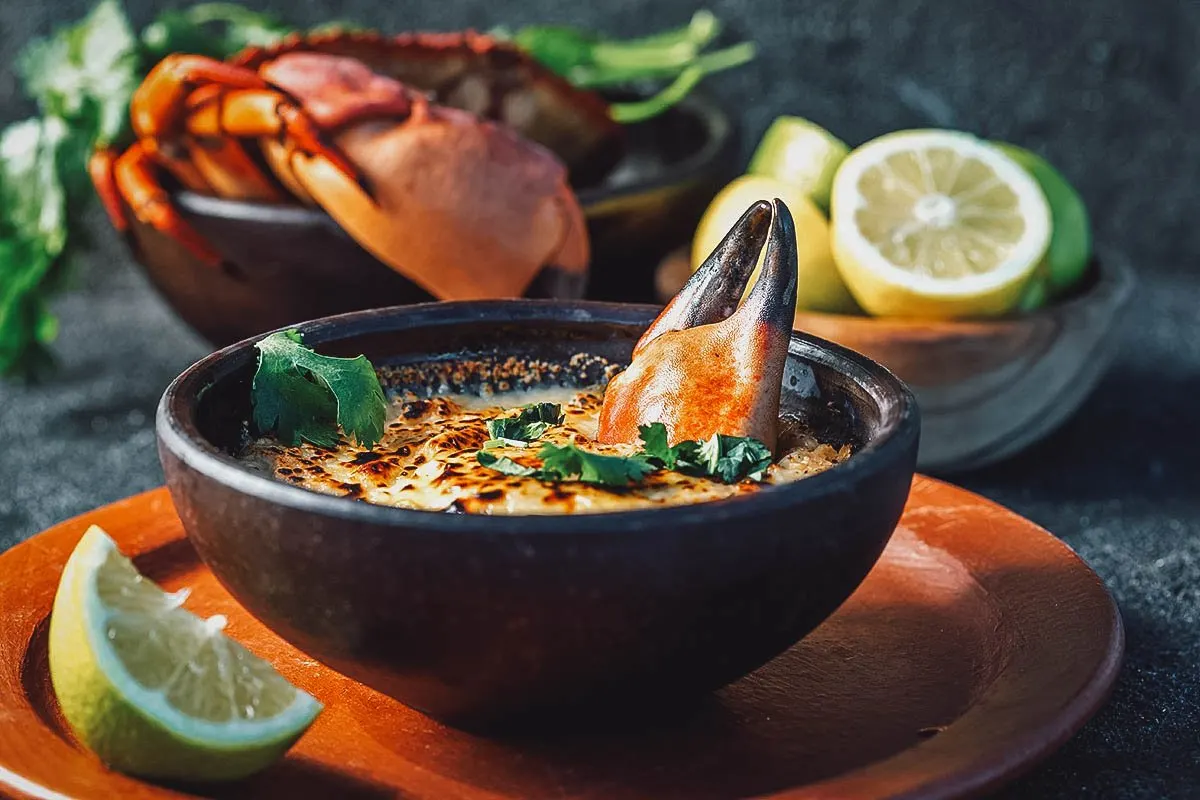
Photo by Blinovita
33. Curanto
Curanto is an ancient method of food preparation that originated in Chile’s Chiloé archipelago. The word curanto means “stony ground” and refers to the method of cooking seafood, meat, and potatoes in a pit lined with rocks.
To make curanto, a hole about a meter deep (3.3 ft) is dug into the ground and lined with stones. A wood fire is lit to heat the stones. Various ingredients like shellfish, meat, sausages, and potatoes are loaded into the hole before it’s covered with wild rhubarb leaves, damp sacks, and dirt. As the shellfish cooks, the shells open and release a liquid that sizzles on the hot stones to help steam the food.
Summers are the best time to try traditional curanto in Chile. During the wetter winter months, restaurants will offer curanto en olla or “curanto in a pot” which is a stovetop version of this ancient meal.
The ingredients aren’t constant but a proper curanto needs to be made with a variety of potatoes cooked in three ways – whole steamed, dumplings (chapaleles), and pancakes (milcaos).
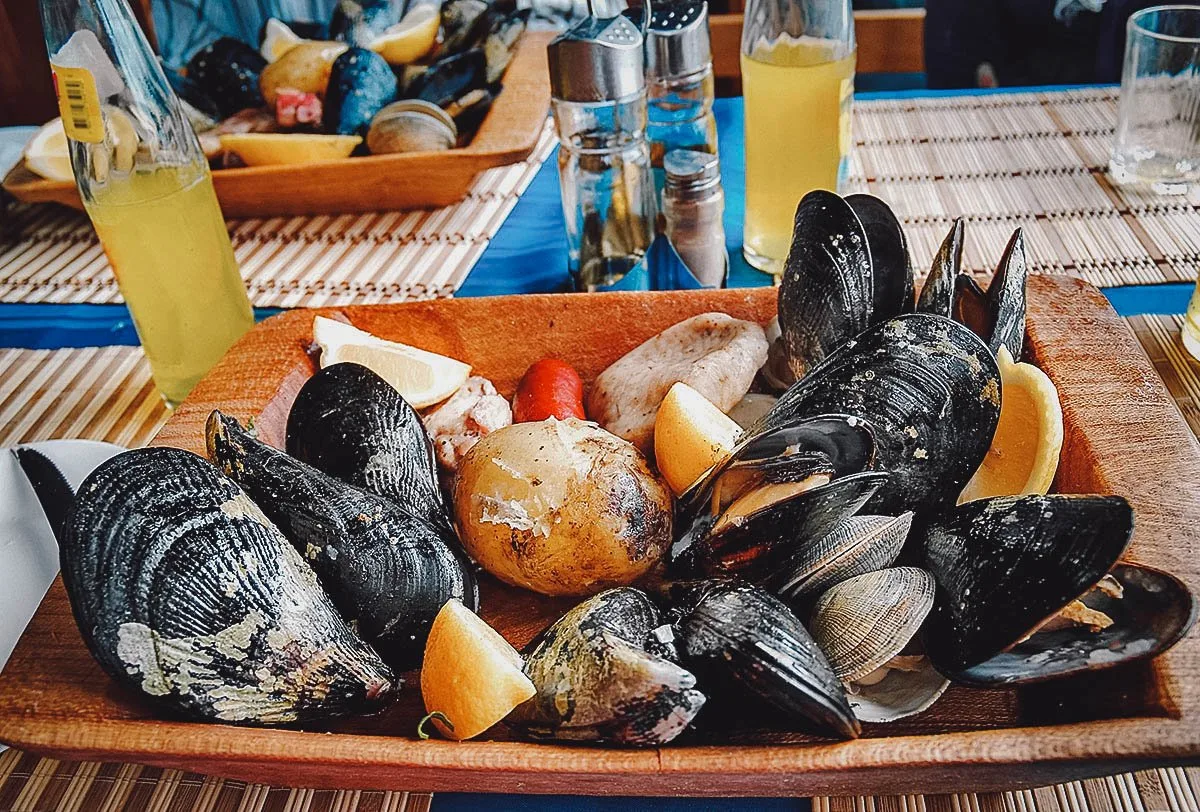
Photo by YAYImages
34. Ceviche
Ceviche is a widely consumed South American dish consisting of fresh raw white fish cured in citrus juices. It’s originally from Peru or Ecuador but it’s become popular throughout the Pacific coastal regions of Latin America and beyond.
Traditionally, ceviche is prepared with the juices from bitter oranges but it’s now more common to make it from lime or lemon juice. The citric acids from the fruit causes the fish to become denatured, giving it the appearance of being cooked.
In Chile, ceviche is typically made with halibut or Patagonian toothfish (commonly marketed as Chilean sea bass) marinated in a mixture of lime and grapefruit juices, finely minced garlic, and red chili peppers. On Easter Island, it’s more commonly made with tuna marinated in lemon juice and coconut milk.
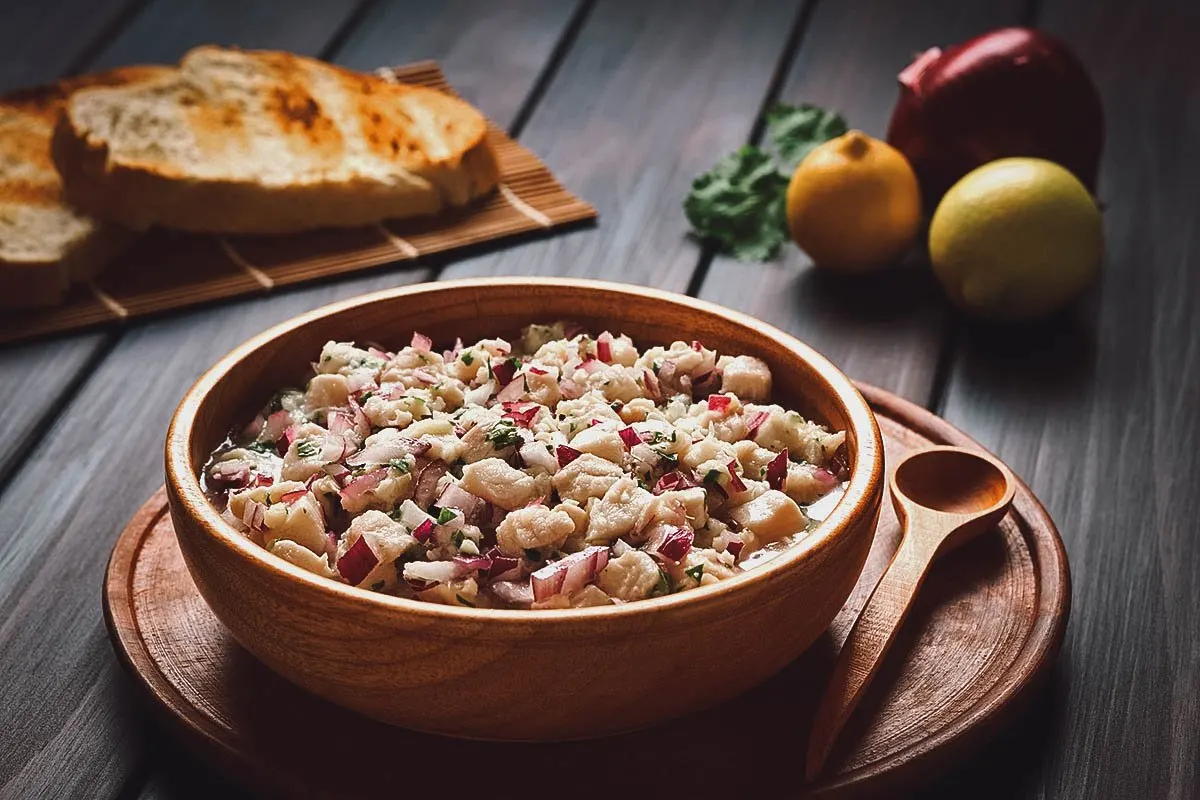
Photo by ildi_papp
35. Picoroco
We love trying new and exotic food and picoroco, like percebes, is exactly the type of dish we’d fly for. Meaning “beak in the rock”, picoroco refers to a giant barnacle that lives along the shores of Chile and southern Peru. They attach themselves to rocks and develop hard calcite layers that resemble dual-pronged beaks, hence the name.
When cooked, picoroco tastes sweet and briny. They’re crab-like in flavor and have a slightly chewy interior surrounded by a creamier outer layer. They frequently make their way into curantos or soups and are often baked into creamy pasteles.
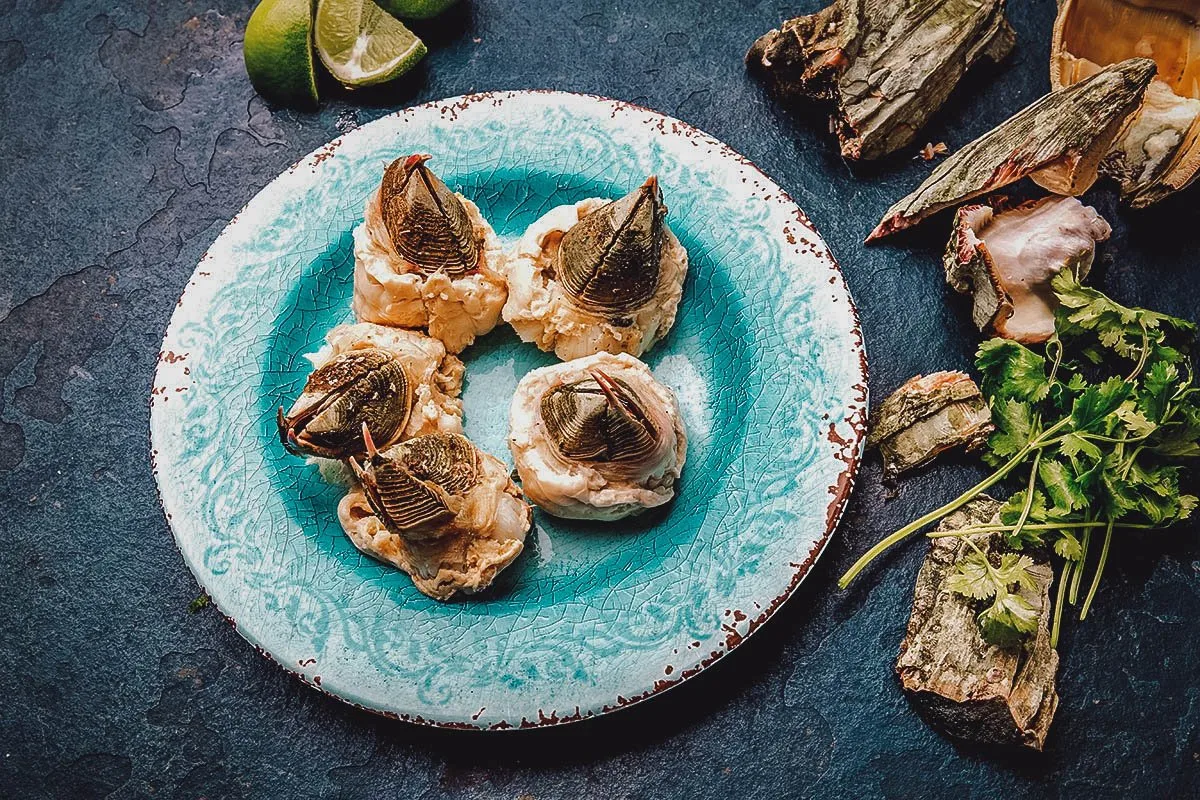
Photo by Blinovita
DESSERTS / DRINKS
36. Chilenitos
Chilenitos are a Chilean variation of alfajores, the beloved confection made with rich and creamy dulce de leche sandwiched between two round shortbread cookie sandwiches. What makes chilenitos different is that they’re traditionally covered in meringue.
Chilenitos are said to have been invented in Curacaví. This city was an obligatory stop for people traveling between Santiago and Valparaíso. At the time, inn keepers would offer sweets to their guests so they began baking alfajores coated in meringue to help them last longer.
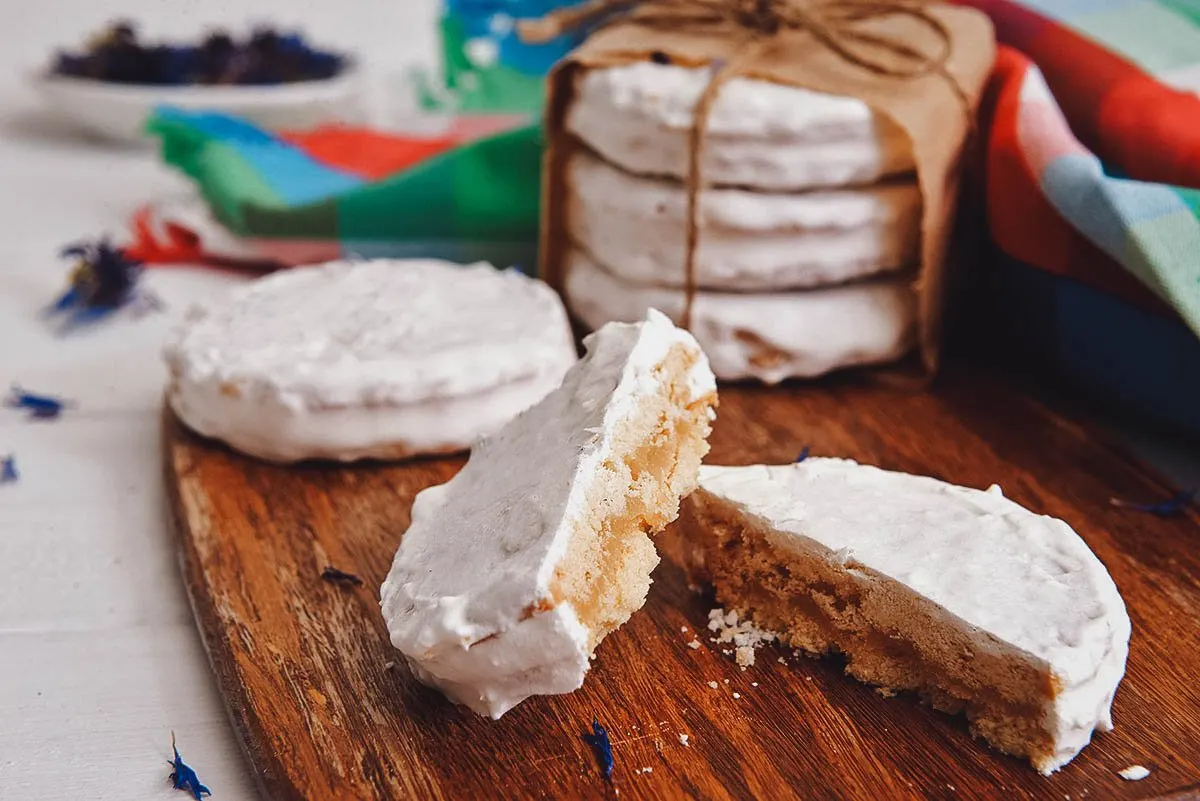
Photo by bunbomi
37. Calzones Rotos
These oddly-shaped pastries resemble breeches, which help explain the funny-sounding name. Calzones rotos means “torn underwear” and refers to a crispy fried pastry made with a dough enriched with almonds, Chilean pisco brandy, and citrus zest. They’re European in origin and very similar to chruściki or Polish cruller cookies.
It’s likely that calzones rotos got their name from their distinctive shape, but a more humorous origin story suggests otherwise. According to legend, a woman was selling traditional pastries at the Plaza de Armas in Santiago when a gust of wind blew up her skirt, revealing her torn panties.
Regardless of how it got its name, calzones rotos are a delicious Chilean dessert that’s especially popular in winter.
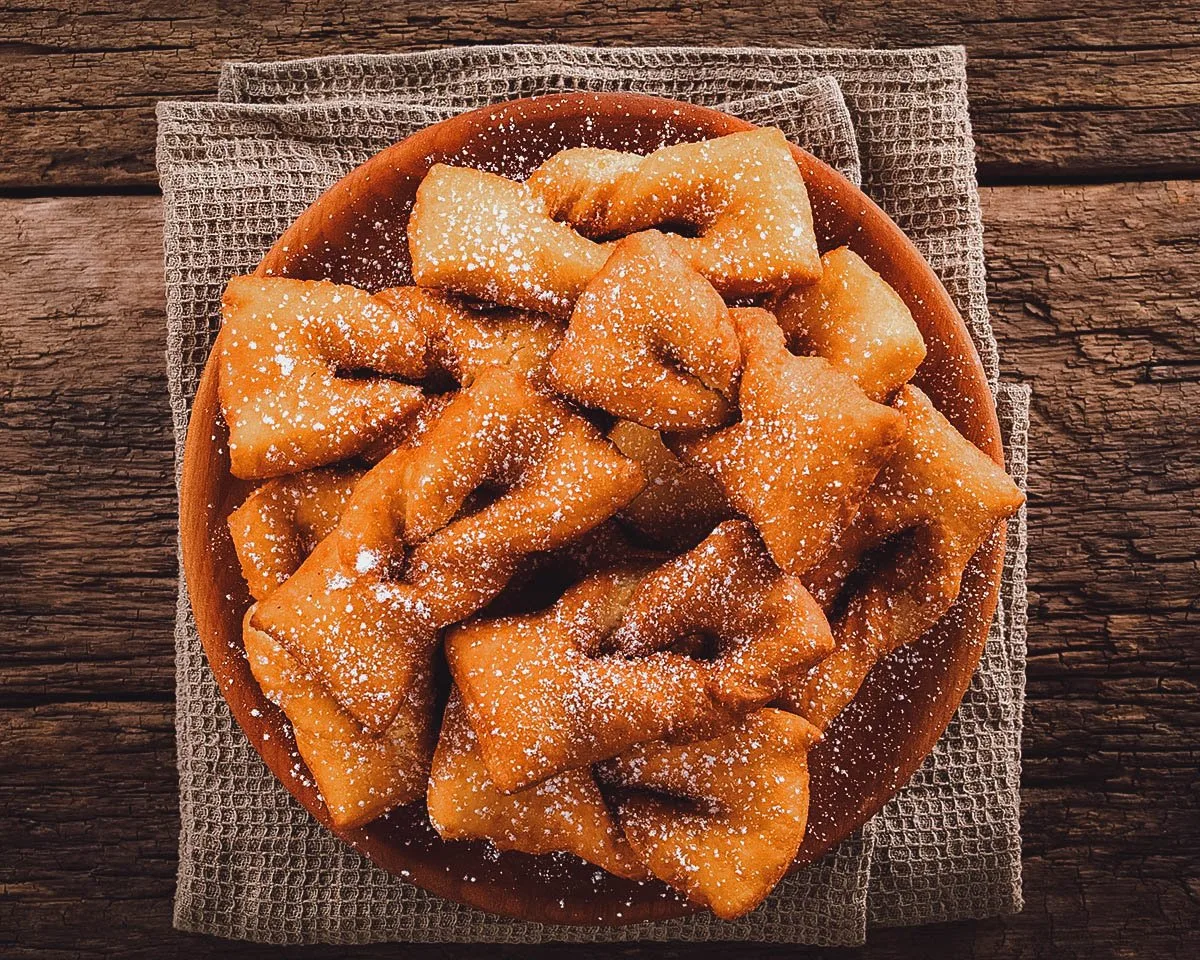
Photo by PantherMediaSeller
38. Pan de Pascua
The name of this cake may be confusing at first. Pan de pascua literally means “Easter bread” but it describes a cake that’s traditionally eaten for Christmas in Chile. This is because the word pascua can refer to both Easter and Christmas in Spanish.
Pan de pascua is a rich and dense Chilean holiday cake that’s said to be derived from Italian panettone and German stollen. Similar to a fruit cake, it’s flavored with rum and spices and filled with candied fruits, raisins, almonds, and walnuts.
Pan de pascua is traditionally paired with cola de mono, a Chilean holiday beverage made with warm milk infused with cinnamon, cloves, coffee, and aguardiente.
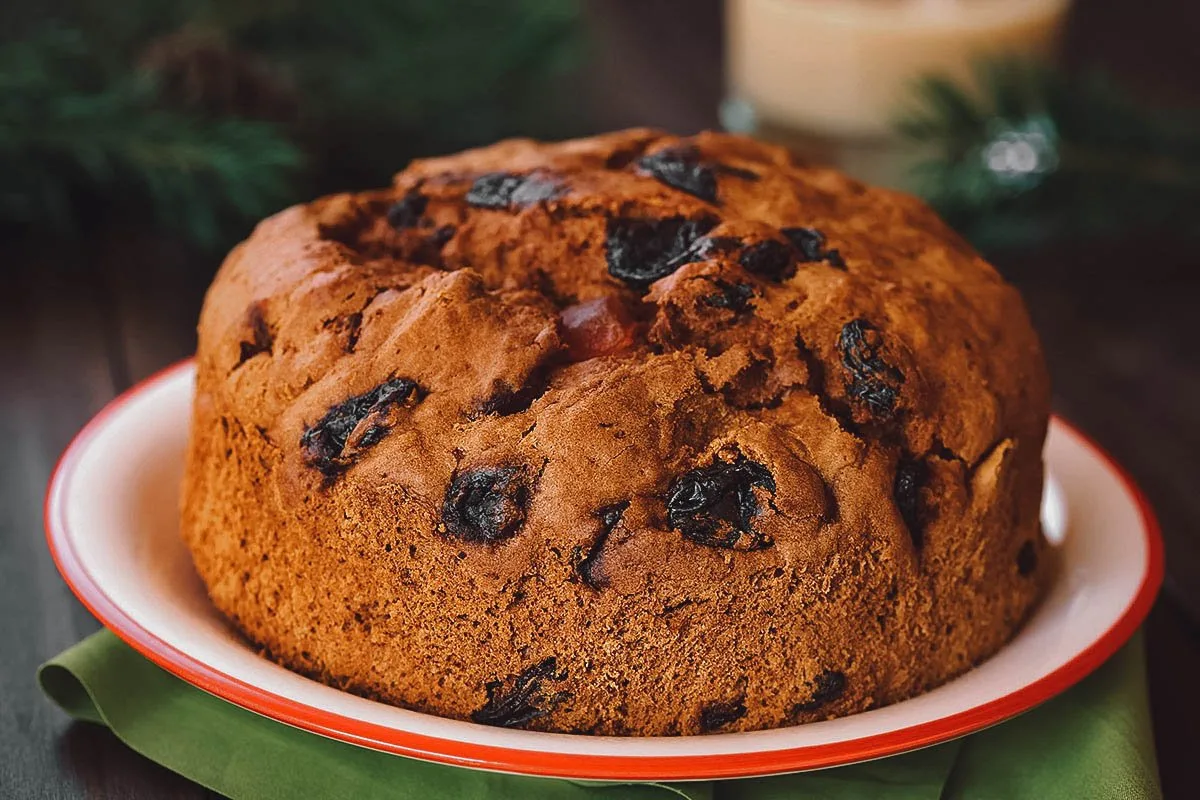
Photo by ildi_papp
39. Mote con Huesillo
Mote con huesillo is the perfect Chilean drink to cool off with in summer. Sold from street food stands and mobile carts everywhere in Chile, it refers to a traditional summertime drink made with hulled wheat (mote) and a sweet nectar-y liquid derived from dried peaches (huesillo).
To make mote con huesillo, dried peaches are rehydrated and then cooked in a sugar and water mixture. The hulled wheat is cooked separately in water until tender and then added to the sweet huesillo mixture. The drink is chilled before serving, usually in a glass with a spoon for easy consumption.
Huesillo and mote both have a long history in Chile. Mote dates back to colonial times while huesillo has been sold in Chile since the late 18th century. Mote con huesillo is so important to Chilean culture that a popular play exploring Chilean identity called “El Mote con Huesillos” has been touring the country since 2012.
When describing something that’s quintessentially Chilean, there’s a local saying that goes “Más chileno que el mote con huesillo”, meaning “More Chilean than mote con huesillo”.
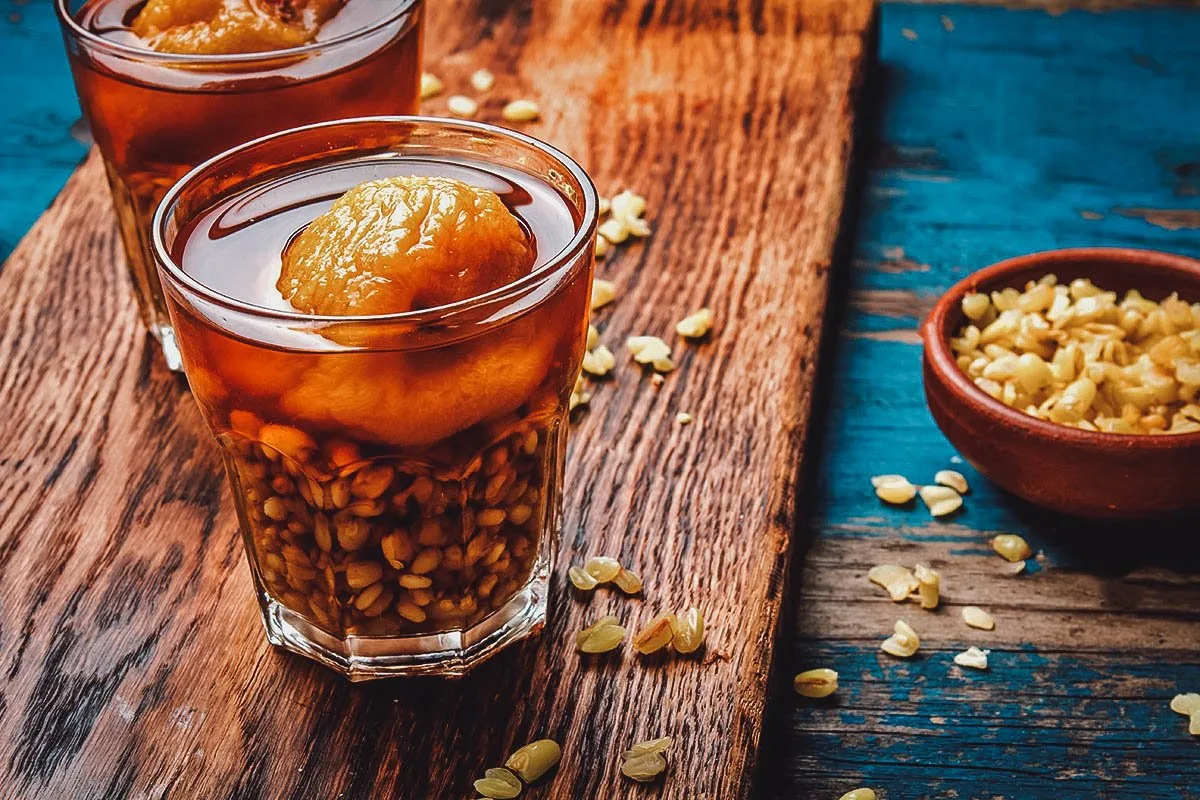
Photo by Blinovita
40. Pisco Sour
Pisco sour is a classic Chilean cocktail made with pisco brandy, a colorless or yellowish-to-amber colored brandy made by distilling grape juice into a high-proof spirit. It can be mixed into many cocktails though none are more popular than pisco sour, which is considered the national cocktail of Chile and Peru.
Recipes vary but at its most basic, Chilean pisco sour is made with a base of pisco brandy mixed with pica lime juice, simple syrup, and ice. The Peruvian version differs slightly in that it’s made with freshly squeezed lime juice and extra ingredients like egg whites and bitters.
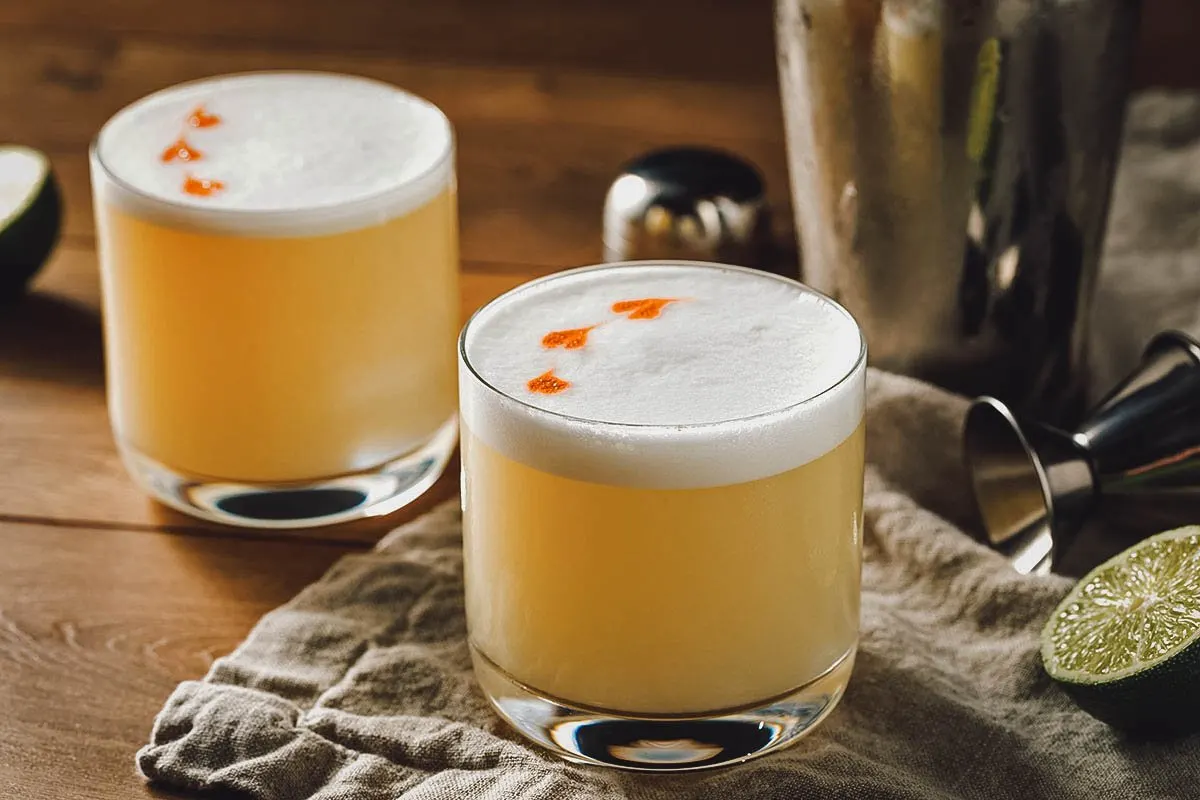
Photo by bhofack2
CHILEAN FOOD TOURS
It’s fun exploring the local cuisine on your own, but if you really want to learn about the food in Chile, then you may want to go on a guided food tour. Not only will a local guide take you to the city’s best restaurants, markets, and street food stalls, but they’ll be able to explain all the dishes to you in more detail. Check out Get Your Guide for a list of food and drinking tours in Santiago and other cities in Chile.
FINAL THOUGHTS ON CHILEAN FOOD
South America has a rich culinary tradition and Chilean food is a testament to that. The cuisines of Peru, Brazil, and Argentina may be more celebrated, but as this food guide shows, there’s just as much to be excited about in Chile. Don’t miss it.
Disclosure
Some of the links in this article on Chilean food are affiliate links. If you make a booking, then we’ll earn a small commission at no additional cost to you. As always, we only recommend products and services that we use ourselves and firmly believe in. We really appreciate your support as it helps us make more of these free travel and food guides. Thank you!
Cover photo by ildi_papp. Stock images via Depositphotos.


Caroline
Friday 5th of May 2023
I'm disappointed that there's no recipe for a delicious Chilean concoction known as Chancho Con Palta. There is (or was, it might be gone now) a restaurant in Santiago that made a delicious sandwich of pork and avocado. I think that's all they made. One stood at a glass-fronted counter and ordered one's sandwich. Behind the counter, thin slices of pork were simmering in a broth. The pork slices were piled onto a bun slathered with avocado. I had this when I lived in Santiago fifty years ago and have never forgotten it. My then-husband, a Chilean, always said it was his favorite thing. That and empanadas. I learned to make empanadas but never had any idea how they cooked the pork for this sandwich, or prepared the avocado.
JB & Renée
Sunday 21st of May 2023
Thank you for the recommendation Caroline! We're planning a trip to Chile next year so we'll definitely look for that.
Gisel
Thursday 14th of July 2022
Pisco sours is from Perú. Pisco is a place too in Perú. Period no comparison ok